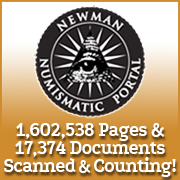
About UsThe Numismatic Bibliomania Society is a non-profit organization devoted to the study and enjoyment of numismatic literature. For more information please see our web site at coinbooks.org SubscriptionsThose wishing to become new E-Sylum subscribers (or wishing to Unsubscribe) can go to the following web page link MembershipThere is a membership application available on the web site Membership Application To join, print the application and return it with your check to the address printed on the application. Print/Digital membership is $40 to addresses in the U.S., and $60 elsewhere. A digital-only membership is available for $25. For those without web access, write to: Terry White, Treasurer AsylumFor Asylum mailing address changes and other membership questions, contact Terry at this email address: terrywhite5475@yahoo.com SubmissionsTo submit items for publication in The E-Sylum, just Reply to this message, or write to the Editor at this address: whomren@gmail.com BUY THE BOOK BEFORE THE COINSale Calendar |
- WAYNE'S WORDS: THE E-SYLUM JANUARY 17, 2018
- NEW BOOK: SEARCH & SAVE: HALF DOLLARS
- ADDENDA TO AMATO'S 1802 HALF DIMES BOOK
- THE NUMISMATIC BOOK CATALOGUES OF GUSTAV FOCK
- THEODORE V. BUTTREY (1929-2018)
- “NUMISMATICS WITH KENNY” ON NEWMAN PORTAL
- NEWMAN PORTAL SEARCH: FISLER
- COLONIAL WILLIAMSBURG ACQUIRES DANISH ABOLITIONIST MEDAL
- WHERE THE 1833 LIBERIA TOKENS WERE MADE
- ANSWER: 1893 COLUMBIAN EXHIBITION MEDAL WINNERS
- ANSWER: WERE THESE COINS MADE BY ISIS?
- HI-TEC BANKING AND THE PREVENTION OF FORGERY
- NOTES FROM E-SYLUM READERS: JANUARY 14, 2018
- ON TOM NOE'S COINGATE CULPABILITY
- ANA PREPARATIONS FOR 2018 NATIONAL COIN WEEK
- VOCABULARY TERMS: COINING DIES AND COLLAR DIES
- MAJOR JAMES OTIS WOODWARD (1862-1928)
- FRANK. C. ROSS AND THE ORPHAN ANNE DIME
- HARVEY STACK'S NUMISMATIC FAMILY, PART 9
- PETER CLAYTON AWARDED JEFFREY NORTH MEDAL
- NUMISMATIC AMBASSADOR WINNERS
- TYRANT COLLECTION AT FEBRUARY 2018 LONG BEACH
- NUMISMATIC NUGGETS: JANUARY 14, 2018
- KüNKER AUCTION 303: SAXONIA IN NUMMIS
- WAYNE'S NUMISMATIC DIARY: JANUARY 14, 2018
- ONLY KNOWN GSA HARD PACK 1893-CC MORGAN DOLLAR
- THE RARE KEW GARDENS 50P COIN
- THE ARAUCANIA – PATAGONIA 100 PESOS
- ARTICLE HIGHLIGHTS ST. LOUIS ELONGATED CENTS
- THE CANADA 150 MEDAL
- INDIAN BEGGARS REFUSING ONE RUPEE COINS
- THE $50 GOLD SLUGS OF GRANVILLE P. SWIFT
- ARTICLE HIGHLIGHTS THE SADDLE RIDGE HOARD
- FEATURED WEB SITE: CHECK YOUR CHANGE
Click here to access the complete archive
To comment or submit articles, reply to whomren@gmail.com
Content presented in The E-Sylum is not necessarily researched or independently fact-checked, and views expressed do not necessarily represent those of the Numismatic Bibliomania Society.
WAYNE'S WORDS: THE E-SYLUM JANUARY 17, 2018
 This week we open with one new book, one addenda, a review of Gustave Fock numismatic literature catalogues, updates from the Newman Numismatic Portal, and word of the passing of Dr.
Theodore "Ted" Buttrey Jr.
This week we open with one new book, one addenda, a review of Gustave Fock numismatic literature catalogues, updates from the Newman Numismatic Portal, and word of the passing of Dr.
Theodore "Ted" Buttrey Jr.
Other topics this week include where the 1833 Liberia tokens were made, ISIS coinage, National Coin Week, Numismatic Ambassadors, the Orphan Anne dime, the Fisler & Chance token, the Jeffery North medal, Saxon coins and medals, the Kew Gardens 50 pence, elongated cents, and the $50 gold slugs of Granville Swift.
To learn more about 1802 half dimes, 1846 dimes, false Western American gold bars, Baghdad Trench Art coins, collar dies, the Elizabeth I gold ship real, the antoninianus of usurper Julian of Pannonia, and the 1872 World's Peace Jubilee medal, read on. Have a great week, everyone!
Wayne Homren
Editor, The E-Sylum
NEW BOOK: SEARCH & SAVE: HALF DOLLARS
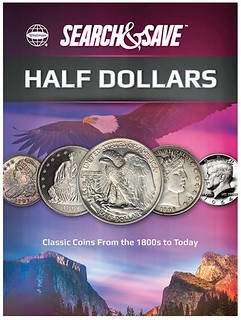 The sixth volume in Whitman Publishing’s library of collector book-albums is Search & Save: Half Dollars, available now for $9.95 retail from booksellers and hobby shops nationwide,
and online (including at www.Whitman.com).
The sixth volume in Whitman Publishing’s library of collector book-albums is Search & Save: Half Dollars, available now for $9.95 retail from booksellers and hobby shops nationwide,
and online (including at www.Whitman.com).
The Search & Save volumes are intended as a guided, hands-on way to get beginning and intermediate collectors involved in active coin collecting by denomination and type. The first five Search & Save books covered Lincoln cents, nickels, State quarters, America the Beautiful quarters, and dimes and quarters. Half Dollars consists of a 96-page hardcover book bound with a Whitman Classic® Coin Album page for storing and displaying a customized coin collection of U.S. 50-cent pieces dating from the 1800s to today.
Search & Save: Half Dollars offers a colorful exploration of American commerce and coinage from the colonial era to the start of the Philadelphia Mint in 1792. Subsequent chapters cover Capped Bust, Liberty Seated, and Barber half dollars (spanning from 1807 to 1915), Liberty Walking half dollars, Franklin half dollars, and Kennedy half dollars. A special chapter explores the field of U.S. commemorative half dollars from 1892 to date, and a final chapter tells how to collect each coin type. The book’s album page allows the collector to display 12 coins of different types and varieties, ranging from Capped Bust half dollars of the early 1800s to today’s Kennedys, plus three of their favorite commemorative half dollars.
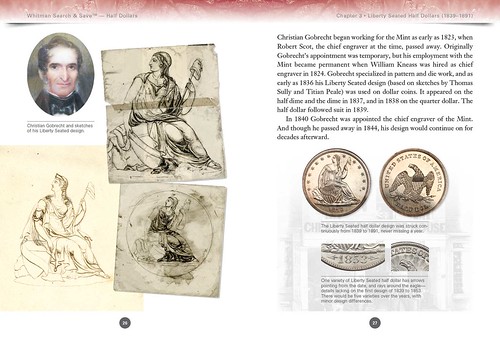
The rigid coin-album page has protective plastic slides that are inserted on each side of the page’s openings, holding each coin firmly in place while allowing its obverse and reverse to be displayed.
Many Search & Save coins can be collected from circulation. Others, such as half dollars, require some hunting at local banks and coin shops, online, or at a coin show. The Half Dollars album page starts with relatively common and easily collectible coins beginning with the Capped Bust type of the early 1800s.
“Readers of our Search & Save books learn about each coin in the context of American and world history, and enjoy the fun and pride of building their own valuable collections,” said Whitman publisher Dennis Tucker. “The books encourage readers to explore beyond their pocket change, to build relationships with coin dealers and go to coin shows. When they’re done they not only have a personalized coin collection, but they can tell each coin’s story and share them with their friends and family. And, we hope, they will think of themselves as active and accomplished hobbyists.”
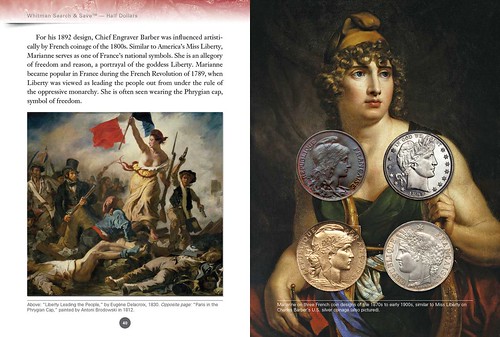
Because Whitman Publishing is the Official Supplier of the American Numismatic Association, ANA members receive 10% off the Search & Save books when purchasing directly.
For more information, or to order, see:
https://www.whitman.com/
To read earlier E-Sylum articles, see:
WHITMAN RELEASES NEW SEARCH & SAVE COIN BOOKS (http://www.coinbooks.org/esylum_v19n23a04.html)
NEW BOOKS: SEARCH & SAVE DIMES, QUARTERS, HALVES (http://www.coinbooks.org/v20/esylum_v20n22a03.html)
ADDENDA TO AMATO'S 1802 HALF DIMES BOOK
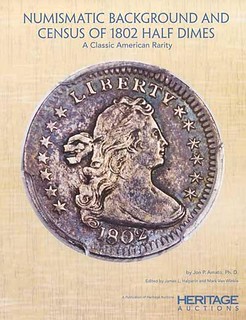 Jon P. Amato wrote Numismatic Background and Census of 1802 Half Dimes, published by Heritage in 2017. On the final page, Amato offered an “Invitation for Reader Response.”
Unfortunately, Amato died shortly after the book was published and before he could react to any reader response.
Jon P. Amato wrote Numismatic Background and Census of 1802 Half Dimes, published by Heritage in 2017. On the final page, Amato offered an “Invitation for Reader Response.”
Unfortunately, Amato died shortly after the book was published and before he could react to any reader response.
Pete Smith has written an Addenda to the Amato book. This includes some additional pedigree information and certification numbers. While the original book was 64 pages, the Addenda is 24 pages.
Amato listed 32 known surviving examples of the 1802 half dime. Smith identifies three that he believes are duplicate listings. He also includes images of seven addition pieces that may not be listed in the Amato book.
The Addenda may be found on the Heritage website. Author Smith will appreciate additions and comments.
To read the complete addenda, see:
Numismatic Background and Census of 1802 Half Dimes (https://coins.ha.com/information/half-dimes-1802.s)
To read the earlier E-Sylum article, see:
NEW BOOK: 1802 HALF DIMES (http://www.coinbooks.org/v20/esylum_v20n20a02.html)
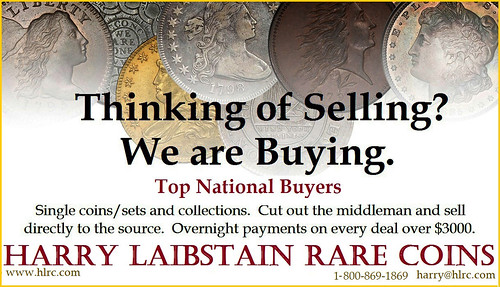
THE NUMISMATIC BOOK CATALOGUES OF GUSTAV FOCK
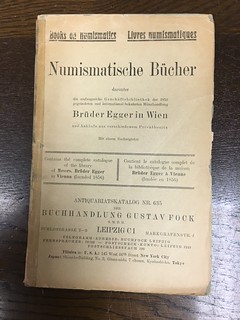
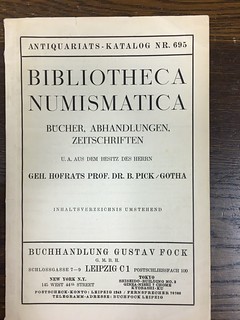
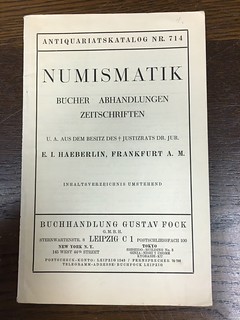
I recently re-discovered on my library shelves a bound volume of book catalogues issued in the 1930’s by the firm of Gustav Fock of Leipzig. All are printed on thin paper, newspaper-style stock, and slightly age-browned.
In recent years some major numismatic libraries have been sold - at auction.
The Hess library was sold, at auction, by Peus, Frankfurt/M in 1991. It took two days to sell, and included 2746 lots.
The (remaining part of) the Rollin & Feuardent library was sold, at auction, by Drouot, Paris in 1993 in two sessions on one day, and comprised 444 lots.
The (remaining part of) the Jacques Schulman library was sold by Frankfurter Munzhandlung, Frankfurt/M, at auction, in 1995, containing 1726 lots.
The M and M library was sold, at auction, by Kunker, Osnabruck in 2005. It took two days and comprised 3589 lots.
During the inter-war years in Germany, the leading academic bookseller was Gustav Fock GMBH, of Leipzig. The business had been established in 1879, and whilst it had no doubt faced hardships during the Second World War and into the Soviet period, it struggled on, but finally, in 1955, it closed its doors.
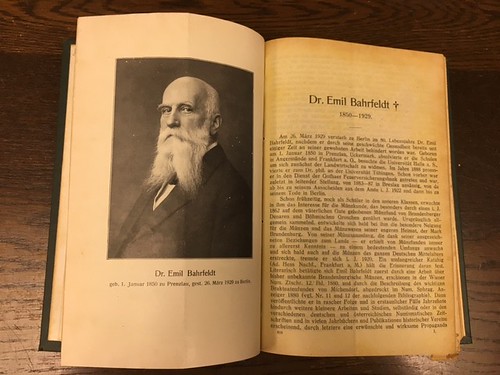
Fock’s Katalog 619 was published in 1930. It included the Library of Dr. Emil Bahrfeldt of Berlin (1850-1929). It ran to 136 pages and included some 2819 items for sale, at fixed prices. The catalogue included, as a frontispiece, a fine photographic portrait of Bahrfeldt, and was preceded by an 8-page list of his published works, including no less than 261 papers, books and other publications.
The catalogue concludes with 8 pages of advertisements by coin dealers: Riechmann & Co, (Halle- Saale), Holmbergs (Stockholm), Meuss (Hamburg), Adolph Hess (Frankfurt/M). Fock himself also advertised for sale mahogany coin cabinets. Oxford University Press offered Barclay Head’s 2nd edition of his Historia Numorum (1911) at 50 shillings, and Hill’s Medals of the Renaissance (1920) at a similar price. G.E.C. Gad. of Copenhagen advertised Schou’s Beskrivelse af Danske og Norske Monter, published 4 years earlier, in 1926, at 75 kroner, along with three of Wilcke’s handbooks, published in 1921,1927 and 1929, all at low prices. De Gruyter of Berlin were promoting Boehringer’s, still an essential work today, Die Munzen von Syrakus, published in 1929, at 80 reichmarks.
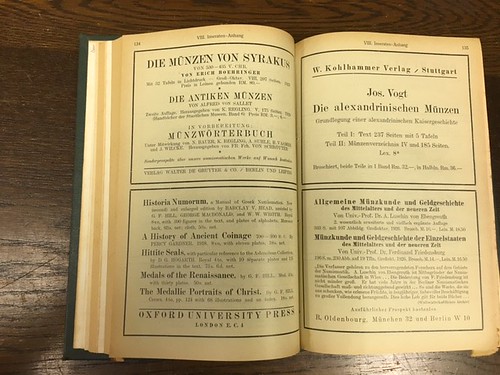
Amongst the gems offered for sale in the catalogue, all priced in reichsmarks, were 89 volumes of the Numismatic Chronicle, 1838 – 1929, plus the Journal, 1836-1838, for 1250 RM; BMC Greek “Complete in 28 volumes” for 2500 RM - the final volume, covering Cyrenaica, was published after Bahrfeldt’s death. Spink’s ‘Circular, volumes 1-37 (1893-1929)- a complete run, could have been had for 480 RM, the first 14 Ars Classica sales, 1920-1929, for 350 RM, a single volume of Pellerin’s Recueil, with 64 plates, for 16 RM, and, exceptionally, a complete set of Reichel’s Munzsammlung, St. Petersburg, 1842-1850 (“NIcht uniform gbdn”), for 900 RM. Ricauld de Tiregale’s magnificent Medailles de Pierre le Grand, Potsdam, 1772- “avec portr. et nombre grav. Folio”, was just 90RM…..
Later in 1930, and what must have been a veritable coup for Fock, he offered the complete library of Messrs Bruder Egger of Vienna. In Catalogue 635 (Antiquariatskatalog Nr. 635), he listed for sale, again at fixed prices, some 2568 items in 160 pages. Towards the end of this catalogue are two pages, promoting reprints of standard works that Fock were offering on subscription: Sabatier’s two-volume Description general des monnaies Byzantines…. To be published December 31, 1930 at (what seems to be a very reasonable) 48 RM. The second reprint, offered here, and just published, was Henri Cohen’s 2nd edition of his great reference work: Description Historique des monnaies frappes sous l’Empire romain; at 400 RM. Seemingly to justify his price, Fock says in his two-page promotional text that copies of the original would sell for 1500 RM…..
In the catalogue itself, a complete set of the Zeitschrift fur Nukismatik- 37 volumes (1874-1927 + the register) could be had for RM 1000, in wrappers, or for an additional 125 RM, in half cloth - did they have two sets ….? On the final page of the Catalogue – almost as an afterthought, or simply perhaps to fill valuable selling space, they offered the magnificent and excessively rare 12 volumes of Georg Michailowitsch’s “Russische Munzen” 1888-1901…. For 1100 RM… and Svoronos’ Ptolemies, complete in 4 volumes, 1904-1908… for 250 RM.
Fock’s Katalog 651, again appearing in 1930, covered the whole spectrum of the subject, ran to 144 pages, and included 3089 items; it included 4 pages of advertisements at the end of the catalogue, by the likes of: Edmund Rappaport of Berlin; and Fock’s near neighbour, Friedrich Redder, of Leipzig; the flourishing Jacob Hirsch, now firmly-established in Geneva was promoting his 10-year old Ars Classica business, as well as his very recently-established dealership in fashionable New York: Dr. Jacob Hirsch Inc. 30 West 54 th Street. Scott Stamp & Coin Company, also of New York, took a full-page, and advertised their Wayte Raymond publications, all priced at between 25c and $1.
Fock triumphed again, in 1934, with Catalogue 695, including books from the library of Prof. Dr. B. Pick, of Gotha. It ran to 144 pages, and included no less than 3496 items. Amongst the thousands of items listed for sale were Dessewffy’s (now) rare Barbar penzei, 1910 (“mit 54 taf”) - for 7.50 RM; and Donop’s (now) exceptionally rare description of the Jersey Hoard: Les Medailles Gallo-Gaeliques, with 32 plates, 1838, for just 10 RM.
The final two such catalogues of numismatic libraries issued by Fock seem to have been 710 (January 1937) and 714 (October 1937). The former included the libraries of three Professors: Holzinger, of Prague, Reisch, of Vienna, and Studniczka of Leipzig, and comprised items (4001) - 8758, on 154 pages.
The second, Catalogue 714, included the huge library of Justizrats Dr. Jur. E. J. Haeberlin of Frankfurt/M. It ran to no less than 136 pages and listed 3495 items for sale.
By this time, Bernard Quaritch in London had already established himself as one of the leading academic booksellers in Europe. He was the sole distributor of the Royal Numismatic Society’s Numismatic Chronicle, and handled the publications of many Learned Societies in Europe. His Catalogue 469 was published in 1933, ran to 44 pages, and listed for sale some 574 items. It included many rarities: Adler’s Museum Cuficum Borgianum Veletris, 1782, in half calf, and offered at 16 shillings; two copies (yes!) of Anderson’s beautifully produced Selectus Diplomatum et Numismatum Scotiae Thesaurus, 1739- one in red morocco, gilt edges at £4. 4. 0 , whilst the other, in “old Russia, gilt” for a guinea less. Quaritch also had BMC Greek, complete- Quaritch says “Complete as far as published” (it has never been completed) in 29 volumes, in cloth - it must have been “as new”, surely…… for a relatively high £75; the complete 10 volumes of BMC Oriental (1875-1890), in cloth - and already, in 1934, he says “Very scarce”, for £30, and Quaritch did also have a few volumes that he offered singly….. John Evelyn’s Numismata, 1697, in “contemporary calf, joints neatly repaired” was on offer at a seemingly low £1.1. Mionnet’s Description de Medailles, 1806-1813, plus the Recueil de Planches, 1808, the Supplement, 9 volumes, 1818-1837, and the Tables, 1837- 17 volumes in all, in “half green roan, uncut” appears to be a bargain at £22.10, as does the set of Numismatic Chronicle, including both the Journal, 1836-1838, and the Proceedings, and Institutes, from 1836 – so, all in all, complete from 1836-1930; bound in “full and half calf, a very fine set”, for a low £52. A collection of (most of) Sestini’s numismatic works 1789-1831, and all listed fully in the catalogue, and bound in 9 volumes in half calf- “a little worn”…….could have been had for the low price of £10.10.
Some eleven pages of the catalogue were given over to auction, and privately-issued catalogues – a quite remarkable selection, including Spink’s Catalogue of Montagu’s Milled Coins, 1891- for 6 shillings….. Many, if not most, of the sales catalogues were priced with the buyers noted. The section included 6 parts of Montagu’s sales(1895-1897), bound in half calf- for £1.2s- and they were all hand priced, and with the buyers noted….. Murdoch’s 8 sales, bound in two volumes, also priced and with the buyers, and again in half calf - was offered for 3 guineas… ….. Leonard Forrer’s Catalogue of Sir Hermann Weber’s Greek Coins, certainly still in print at the time, and published by Spinks, who were just down the road in Piccadilly –perhaps they had already just recently moved to KIng Street – in any case, not far from Bernard Quaritch, was offered for 12 guineas.
THEODORE V. BUTTREY (1929-2018)
Buttrey of course is known in the U.S. for calling out false Western American gold bars and battling with the legendary John J. Ford, Jr. Thanks to David Fanning for word of Ted's death and Philip Mernick for pointing me to Buttrey's Wikipedia page, from which I've excerped the following information. The photo is from Buttrey's page at the University of Michigan. -Editor
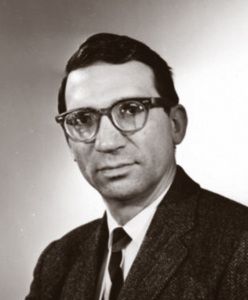 Theodore Vern Buttrey Jr. (born Havre, Montana December 29, 1929, died Cambridge, UK January 9, 2018) was an American educator, classicist and numismatist. He is perhaps best known for his
work discovering and exposing a scheme to distribute fake Western American gold bars.
Theodore Vern Buttrey Jr. (born Havre, Montana December 29, 1929, died Cambridge, UK January 9, 2018) was an American educator, classicist and numismatist. He is perhaps best known for his
work discovering and exposing a scheme to distribute fake Western American gold bars.
Personal
Buttrey was born in Havre, Montana on December 29, 1929, the son of Theodore V. Buttrey Sr. and Ruth Jeanette (Scoutt) Buttrey and the grandson of Frank A. Buttrey, the founder of Buttrey Food and
Drug. He was educated at Peacock Military Academy, graduated from the Phillips Exeter Academy in 1946, and graduated magna cum laude with a degree in Classics from Princeton University in 1950. He
was awarded his Ph.D. from Princeton in 1953, and after obtaining a Fulbright Scholarship for further study in Rome, began his academic career at Yale University in 1954. Buttrey's first marriage
produced four children and ended in divorce; a second marriage produced no children and ended likewise. Buttrey was survived by his third wife, whom he married in October of 2017.
Career as Professor
In 1964, Buttrey took a position in the Classics Department at the University of Michigan. He was promoted to (full) Professor in 1967, and served as Chair of the Department for several years. From
1969 to 1971 he was also the Director of the Kelsey Museum of Archaeology at the University of Michigan. He is remembered as part of the University's Faculty History Project which includes a
statement from the University's Regents.
Buttrey had been a Visiting Fellow and Resident Member of Clare Hall, Cambridge University. After retiring from Michigan he moved to Cambridge where he was an Affiliated Lecturer in the Faculty of Classics. He served as Keeper of Coins and Medals at the Fitzwilliam Museum from 1988 to 1991 and from 2008 until his death held the post of Honorary Keeper of Ancient Coins.
Numismatic Work
Coins of Ancient Greece and Rome
Buttrey spent many years active in research on coins of the ancient Mediterranean. He and his collaborators documented the coinage of Sardis, in modern-day Turkey (and formerly under the control of
the Persian and Roman Empires), and, as part of a long-term Princeton University project, he also investigated the coinage at Morgantina, in modern-day Sicily. He was involved in the publication of
the numismatic finds from numerous excavations in Britain, Italy (Cosa, Rome Palatine, Rome Forum), Libya (Apollonia, Cyrene, Euesperides), and Israel.
Coins of Mexico
It was as a child at the Peacock Military Academy in San Antonio, Texas that Buttrey first encountered, and became interested in, the coins of Mexico. Although as an adult his primary professional
pursuits as a scholar were elsewhere, he continued his interest in Mexican coins into adulthood as well. His "Guidebook of Mexican Coins, 1822 to Date" (1969), together with subsequent
editions (up to the 6th Edition in 1992, this one with first author Clyde Hubbard) is considered the seminal work on the subject.
Fake Mexican and Western American Gold Bars
Although the bulk of Buttrey's academic output concerned coins of antiquity, Buttrey was directly involved in a controversy regarding Western American gold bars that he described as counterfeit.
This followed earlier, apparently uncontroversial, work in which he was able to identify certain Mexican gold bars as counterfeit, primarily by cataloguing anachronistic assayer markings. That
earlier work was capped by Buttrey's 1973 talk, "False Mexican Colonial Gold Bars" at the International Numismatic Congress. In 1984, the American Numismatic Society passed a resolution
supporting Buttrey's assertions.
The dispute regarding the Western American bars was quite possibly the only time a dispute among academic numismatists reached the pages of major newspapers, including the New York Times. Buttrey's claims about the authenticity of the western bars were first detailed in a 1996 talk at the ANS. They were based in part on mint and assay markings that he said were incongruous or inconsistent. He also noted that many of the bars in question had no provenance at all, never appearing in catalogues or other materials from the time that the bars were allegedly produced through the 1950s.
To read the complete Wikipedia article, see:
Theodore V. Buttrey Jr. (https://en.wikipedia.org/wiki/Theodore_V._Buttrey_Jr.)
To read the Michigan Faculty History page, see:
Theodore V. Buttrey (https://www.lib.umich.edu/faculty-history/faculty/theodore-v-buttrey)
“NUMISMATICS WITH KENNY” ON NEWMAN PORTAL
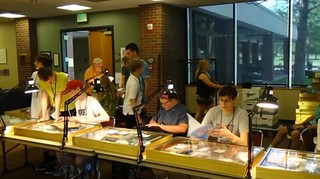 “Numismatics With Kenny” is a video series created by YN (young numismatist) Kenny Sammut of the Wilmington Coin Club. This series is now in its fourth year and numbers well over a hundred
videos, including video from ANA Summer Seminars and Wilmington Coin Club meetings.
“Numismatics With Kenny” is a video series created by YN (young numismatist) Kenny Sammut of the Wilmington Coin Club. This series is now in its fourth year and numbers well over a hundred
videos, including video from ANA Summer Seminars and Wilmington Coin Club meetings.
Sammut’s videos capture, in a way that only video can do, the experiences of being a high-school aged collector. Videos are typically several minutes and range from unboxing the latest delivery of coins received in the mail (who cannot identify with the excitement of doing this for the first time?) to interviewing other YN attendees of the ANA Summer Seminar. A trip to the local coin store might also be found, or an explanation of the ANA’s “Coins for A’s” program. Would that we had such a record from 50 or 100 years ago! The Newman Portal acknowledges Sammut for granting permission to cross-post these videos, which are currently published on YouTube.
Links to 2017 ANA Summer Seminar interviews (parts I and II):
https://nnp.wustl.edu/library/book/532700
https://nnp.wustl.edu/library/book/532797
Link to Numismatics With Kenny on Newman Portal:
https://nnp.wustl.edu/library/multimediadetail/515049
Link to Numismatics With Kenny on YouTube:
https://www.youtube.com/channel/UCTqmf7rIfZpoACFI7-hY-8w
NEWMAN PORTAL SEARCH: FISLER
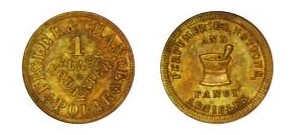 This week an NNP user searched for “Fisler.” I speculated this referred to an American token, and for once made a correct guess. The token has only a few auction appearances, the most
recent being Stack’s sale of the Alan Bleviss collection of Civil War tokens (part IV) in March, 2010, where it realized $920. Another example is found in the Presidential Coin and Antique sale #84
(McSorley), July, 1998.
This week an NNP user searched for “Fisler.” I speculated this referred to an American token, and for once made a correct guess. The token has only a few auction appearances, the most
recent being Stack’s sale of the Alan Bleviss collection of Civil War tokens (part IV) in March, 2010, where it realized $920. Another example is found in the Presidential Coin and Antique sale #84
(McSorley), July, 1998.
These tokens were issued by Fisler & Chance, druggists in Urbana, OH. Dave Bowers, writing in the Bleviss catalog, notes: "The location of Fisler & Chance was finally determined in April 2003 by Mark Gatcha. The firm was in Urbana, Ohio, and consisted of Dr. Israel Fisler and Dr. Samuel Chance, at 15 North Main Street. Fisler was a quartermaster in the 52nd Ohio Infantry, Companies F and S, from May 29, 1862, until he resigned on November 20, 1862…..”
The earliest mention of Fisler & Chance found on the Newman Portal is from October 1898, in Malcolm Storer’s listing of medals, jetons, and tokens related to medical science, which appeared in the American Journal of Numismatics, vol. 33, no. 2.
Image: Fisler & Chance token from Stack’s sale of the Alan Bleviss Civil War token collection (March, 2010), lot 196.
Link to Stack’s Bleviss catalog (March 2010):
https://nnp.wustl.edu/library/auctionlots?AucCoId=3&AuctionId=517023&page=32
Link to Presidential Coin & Antique catalog of the McSorley collection (July 1998):
https://nnp.wustl.edu/library/auctionlots?AucCoId=511514&AuctionId=511916&page=83
Link to American Journal of Numismatics, vol. 33 (October 1898):
https://nnp.wustl.edu/library/book/511737?page=78

COLONIAL WILLIAMSBURG ACQUIRES DANISH ABOLITIONIST MEDAL

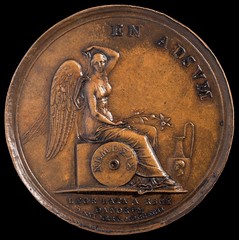
One of the most important medallic items related to the Atlantic slave trade and one of Denmark’s most iconic medals is now part of the Colonial Williamsburg Foundation’s collections. Designed by the Danish artist Nicolai Abildgaard and struck in bronze in 1792 from dies by the Italian medalist Pietro Leonardo Gianelli, the extremely rare piece commemorates that year’s royal edict ending trade in enslaved persons on Danish ships. Only a small handful of these medals produced in a variety of metals are known to exist: white metal examples are in Danish museums and others, held in private collections, were struck in bronze and silver.
“The items of Colonial Williamsburg’s collections capture tangibly our complex, shared history,” said Mitchell B. Reiss, Colonial Williamsburg president and CEO. “In this rare 1792 medal we see an Atlantic power affirming the humanity of a people exploited as property, as well as a foretelling of abolition in America. We welcome our guests 365 days a year—and especially in February during Black History Month—to experience the diverse stories of our nation’s founding.”
In Denmark in 1792, as the move towards banning slavery was taking hold throughout Europe and two years before Congress prohibited the slave trade between the United States and foreign countries, Crown Prince Frederik VI, acting as regent for his mentally unstable father, Christian VII, issued what is considered to be the Prince’s most important proclamation: the Edict of the Abolition of the Slave Trade. This decree made Denmark the first European nation to outlaw trade in enslaved persons on ships flying its flag, though the measure did not fully take effect until 1802. This medal, made at the beginning of the abolitionist movement on the European continent, marks a dramatic shift in the way Denmark sought to treat the enslaved African population in the nation’s Caribbean colonies, the Danish West Indies.
The male head depicted in profile on the face of the medal is likely the oldest Danish naturalistic portrait of an African. The Latin phrase “Me Miserum” (“Woe is me” or “Poor me”) is imprinted as a border around the profile. The reverse image shows the mythological winged goddess Nemesis, who was thought to be the avenging goddess of divine indignation against and retribution for evil deeds and undeserved good fortune. She is depicted seated and facing forward on a platform decorated with a shield that bears her name while holding an apple branch in one hand and touching her wing with the other. The Latin legends indicate the medal was produced under the Danish King’s law and includes the date of the edict, March 16, 1792.
“This masterfully executed work of medallic art is a benchmark piece for two reasons,” said Erik Goldstein, Colonial Williamsburg’s senior curator of mechanical arts and numismatics. “Not only does it beautifully and sensitively display the portrait of an African man, it also marks the beginnings of the abolitionist movement in Europe.”
The medal was acquired through the Lasser Numismatics Fund and a partial gift by John Kraljevich. It is scheduled for public display in 2020 following completion of the entirely donor-funded $41.7 million expansion of the Art Museums of Colonial Williamsburg. Both institutions, the DeWitt Wallace Decorative Arts Museum and the Abby Aldrich Rockefeller Folk Art Museum, remain open throughout construction.
To read the complete article, see:
Extremely Rare Danish Abolitionist Medal Acquired by the Colonial
Williamsburg Foundation (http://www.artfixdaily.com/artwire/release/993-extremely-rare-danish-abolitionist-medal-acquired-by-the-colonial-)
WHERE THE 1833 LIBERIA TOKENS WERE MADE
Last week, in a side note about the 1833 Liberia token, I wrote:
A search for information on the Liberia token itself did turn up an extensive article by Randy Snyder in the September 2006 issue of Penny-Wise, the official publication of early American Coppers, Inc., but it had nothing to say about who struck the pieces
Bob Leonard writes:
You skimmed over this article too fast. See p. 208; Snyder mentions three possibilities, and John Gibbs and Co. is obviously the correct one. Snyder says that they were actually made for circulation in the United States, not Liberia; the U.S. Mint would never have gone along with that, and importing them from England makes little sense since there was a suitable maker in New Jersey.

Ed Hohertz writes:
Josef Neumann wrote about the 1833 copper cent of Liberia in his seven volume work on copper coins written in 1863 (v. III p119-20 21277). After a description of the token and a brief history of the Colony, a reference is given to Blätter für Münzkunde 1835. 1 Band. Blatt 16 which states in German: 'Diese Münze ist geschlagen in dem Dorfe Belleville, 7 Meilen von Neu York in Nordamerika, wo bedeutende Kupfer, serbergwerke und kupserwaarenfabriken sind.'
In English: 'This coin is struck in the Belleville village, 7 miles from New York in North America, where there are significant copper mine and copper goods factories.'
A search turns up a Belleville in New Jersey, just across the river from Manhattan. The mine was known as the Belleville mine at one time. The relevant article with a fascinating history is found on Wikipedia.
To read the complete article, see: Schuyler Copper Mine (https://en.wikipedia.org/wiki/Schuyler_Copper_Mine)
To read the earlier E-Sylum article, see:
QUERY: MINTMARKS ON U.S.-PRODUCED FOREIGN COINS (http://www.coinbooks.org/v21/esylum_v21n01a12.html)
ANSWER: 1893 COLUMBIAN EXHIBITION MEDAL WINNERS
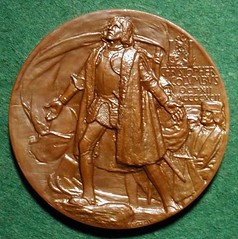
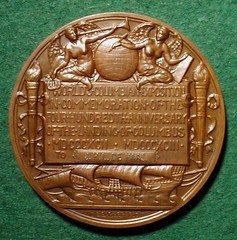
Dick Johnson writes:
The answer is contained in an E-Sylum article I wrote in April 2006 (vol. 9, no. 15, article 15).
After the Philadelphia Mint made the dies they realized they could not produce the raised letters of names demanded by Expo officials. The task was commissioned to Scovill in Waterbury, Conn. Scovill solved the problem of raised lettering of the winners’ names by using INSERT DIES within the cartouche on the medal’s reverse.
Scovill archives are in the Baker Business Library at Harvard University, where at least half of the names are found in a large Journal.
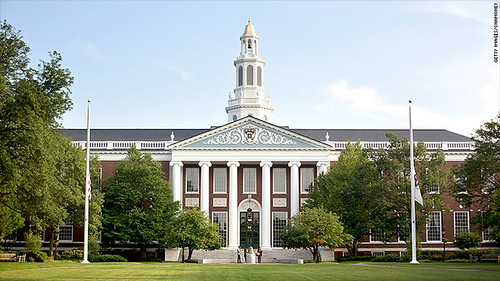
Baker Business Library
The Baker Library has the journal in the Scovill archives which recorded the exact inscription on every Columbian Expo award medal. The trouble is that they have only one journal. The order of 23,757 medals required TWO journals to record all those names. One journal is missing. The existing journal is gargantuan! It must be 4 feet tall, with numbers down the left hand side of each page and a nice [Victorian] hand script entry of the insert die lettering. Does the other journal still exist? It may. Keep digging.
{I estimate] In all, it took Scovill two years to complete this striking order even with a small team of workers. Several engravers creating those insert dies. A pressman or two for striking. A finisher to patina the medals. And several clerks to keep the records straight and to enter those names in that journal. Oh! I do hope the other journal exists.
Because of its size I doubt if photocopies could be obtained. I guess microfilm would have to be ordered. Inquire of the Archive Director.
Below is a closeup showing the insert with the name of the individual winner. -Editor

For more information on the Columbian Exposition Offical Award Medal, see: COLUMBIAN EXPOSITION - OFFICIAL AWARD MEDAL
(http://www.historicalartmedals.com/MEDAL%20WEB%20ENTRIES
/USA/ST%20GAUDENS-COLUMBIAN%20EXPOSITION-BW549%20HIGH.htm)
To read the earlier E-Sylum articles, see:
NOTES FROM E-SYLUM READERS: JANUARY 7, 2018 : Query: 1893 Columbian Exhibition Medal Winners Sought
(http://www.coinbooks.org/v21/esylum_v21n01a10.html)
PORTION OF SCOVILL ARCHIVES SAVED FROM DESTRUCTION (http://www.coinbooks.org/esylum_v09n15a15.html)
ANSWER: WERE THESE COINS MADE BY ISIS?
Chip Howell writes:
From what I can read, these coins say "Islamic State" across the top, and "Caliphate for the Prophet's Pathway" across the bottom. They are all dated 1437 or 1438 (~2015/2016). The metal & fineness is listed at left: nahas (copper; 97.5) or fidha (silver: 99.9). At right is the weight in grams: 5 fils (3g), 10 fils (6g), 25 fils (20g), 1 dirham (3g), & 2 dirhams (6g). The obverse of the dirhams appears to depict "almasjid alaqsa" i.e., the famous mosque in Jerusalem. I wish I could see the 25 fils obverse better: it looks like the recreation of a classic coin, but I can't quite make it out.
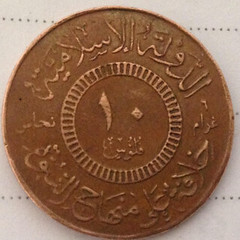
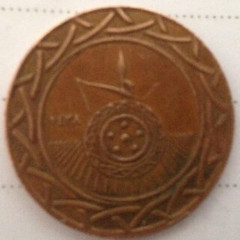
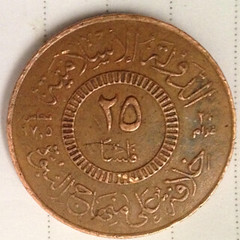

To read the earlier E-Sylum article, see:
QUERY: WERE THESE COINS MADE BY ISIS? (http://www.coinbooks.org/v21/esylum_v21n01a32.html)

HI-TEC BANKING AND THE PREVENTION OF FORGERY
I found David Gladfelter’s article in the Winter 2017 issue of The Asylum - The Nineteenth-Century Bookcase - interesting, and I was pleased to see that the 3rd edition of Ruding’s Annals of the Coinage of Great Britain (1840), and the first edition of Barclay Head’s Historia Numorum, 1887 were regarded as fundamental works by Elvira Clain-Stefanelli.
In the author’s paragraph about Books on Banking, he mentions that one of the few published in the U. S. before 1900 was Lawrence Lewis Jr’s A History of the Bank of North America, 1882. He goes on to describe “an unusual book about bank operations”- it was the third edition of Granville Sharp’s The Gilbart Prize Essay on the adaptation of recent discoveries and inventions in science and art to the purposes of Practical Banking, and was published in London in 1854. It is a quite remarkable and fascinating volume - and I totally agree with David that it “remains a trove for the business historian”. A few years ago I was fortunate to purchase the inscribed copy from Granville Sharp to the donor of the original Prize, J. W. Gilbart. Here is my description of it…….
HI-TEC BANKING AND THE PREVENTION OF FORGERY- THE AUTHOR’S PRESENTATION COPY TO JAMES GILBART. SHARP, Granville. The Gilbart Prize Essay on the adaptation of recent discoveries and inventions in science and art to the purposes of Practical Banking. ... Third English edition, with diagrams and illustrations. London, Groombridge and Sons, 1854.
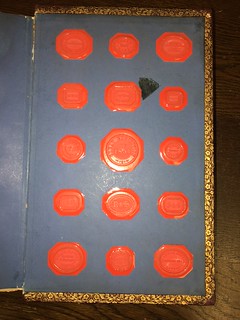 Thick 8vo., steel engraved portrait frontispiece of William Gilbart, with original tissue guard, steel- engraved portrait of Granville Sharp, over 90* other engraved and printed specimens,
samples, drawings and advertisements, several printed on samples of special security and watermarked paper, some folding, a few double-folding, a number of the folding plates torn at the fold, with a
few neatly repaired at folds; some printed in colours; many plates with the stamp of a UK library on the verso; with 15 red wax seals mounted on lower pastedown, all of which in virtually pristine
condition, and illustrating the new process of "tornography"; pp. viii + 356pp., together with numerous other un-paginated leaves describing some of the products illustrated; original (?)
dark maroon morocco, raised bands, back gilt; each cover decorated in gilt, inner dentelles gilt; top edges gilt, others uncut. A very good copy; and the author’s own presentation copy to James W.
Gilbart, the donor of the Prize, and inscribed to him on first free endpaper.
Thick 8vo., steel engraved portrait frontispiece of William Gilbart, with original tissue guard, steel- engraved portrait of Granville Sharp, over 90* other engraved and printed specimens,
samples, drawings and advertisements, several printed on samples of special security and watermarked paper, some folding, a few double-folding, a number of the folding plates torn at the fold, with a
few neatly repaired at folds; some printed in colours; many plates with the stamp of a UK library on the verso; with 15 red wax seals mounted on lower pastedown, all of which in virtually pristine
condition, and illustrating the new process of "tornography"; pp. viii + 356pp., together with numerous other un-paginated leaves describing some of the products illustrated; original (?)
dark maroon morocco, raised bands, back gilt; each cover decorated in gilt, inner dentelles gilt; top edges gilt, others uncut. A very good copy; and the author’s own presentation copy to James W.
Gilbart, the donor of the Prize, and inscribed to him on first free endpaper.
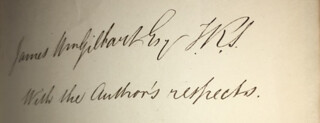
The best, and only illustrated, edition. Inexplicably, not noticed by Murray McKerchar [A papermoney bibliography, Spink, 1979]. Not in AMEX Collection Catalogue. Honeyman: 2844.
It is extremely rare to find an absolutely complete copy, as, apparently, the present example, with most copies being short of the full complement of plates, and the few other examples we have seen have been severely defective.
[A printed explanatory notice, on blue paper, was tipped-in onto the first free-endpaper of an example previously handled by us, and it read:
“Many persons will probably be surprised at finding objects referred to in this work, which appear to have but little connexion with its immediate subject. An explanation may be afforded in the fact that these matters were very cursorily introduced into the original manuscript, with little expectation that it would ever re-appear. As this has however been thrice printed and publicity thereby given to these articles, it is thought that the Exhibitors may be entitled to any advantage which this further publication may afford; and the Author hopes that his readers will cheerfully pass over those parts which they may deem out of place. East of England Bank, Norwich, 10 th June, 1854”]
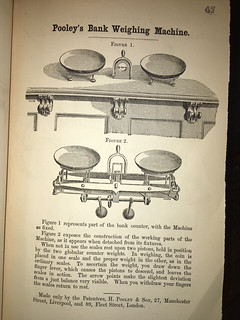 Granville Sharp, the accountant in the East of England Bank in Norwich, is best known to historians of banking for this profusely illustrated book. His slight un-illustrated Essay
first appeared in the Bankers’ Magazine in 1852, and was reprinted as a 44 page pamphlet the same year. For this essay Sharp was awarded the £100 first prize put up by J.W. Gilbart F.R.S.
(1794-1863) the manager of the London and Westminster Bank. The Prize was offered for the best essay to show how the articles and inventions shown at the Great Exhibition of 1851 could be put to
service in the banking industry.
Granville Sharp, the accountant in the East of England Bank in Norwich, is best known to historians of banking for this profusely illustrated book. His slight un-illustrated Essay
first appeared in the Bankers’ Magazine in 1852, and was reprinted as a 44 page pamphlet the same year. For this essay Sharp was awarded the £100 first prize put up by J.W. Gilbart F.R.S.
(1794-1863) the manager of the London and Westminster Bank. The Prize was offered for the best essay to show how the articles and inventions shown at the Great Exhibition of 1851 could be put to
service in the banking industry.
This third edition of Sharp's original paper is no less than a detailed, fully illustrated, report on mid-19th century hi-tec banking. It comprises the widest possible range of technical developments and inventions affecting everything from the fixtures and fittings for a bank, including its heating, lighting, and ventilation, the health of employees, materials required, including inks, paper, pens, and account books, scales, copying machines, printing and engraving, locks, cashboxes, safes, and much else. Improvements in security printing and engraving were the key, however, particularly when the combination of art and science helped to prevent bank note forgery. And so, the first 28 plates all provide samples of bank notes, watermarked security paper, bank cheques and similar material, several on coloured or tinted paper. They include a Perkins' bank note "with combination of difficult engraving", another "faced upon Perkins and Co's patent for the prevention of anastatic and photographic forgery", and several examples of other so-called forgery-proof notes and cheques.
Collation is complicated, at the least, as there are numerous additional inserts. These are, apparently, required leaves, or plates, or examples not listed in the printed list of engravings, and copies seem sometimes to exist with fewer, and more often significantly fewer, inserts, possibly because supply from some of the manufacturers simply ran out. These examples are usually lettered (e.g. plate '13' comprises actually folding leaf '13', five leaves 13A, 13A2 + 13B, 13C, 13D, 13E, 13F, 13G, 13H, 13I, 13K, 13L, 13M, 13N and 13O). Counted thus, the 'total' number of plates, samples and promotional leaflets is about 170.
The present example is of particular interest, having such a remarkable association, being the copy presented by Granville Sharp to James Gilbart, and is apparently totally complete.
UNIQUE.
£3950
NOTES FROM E-SYLUM READERS: JANUARY 14, 2018
Where the Amazonian Pattern Name Came From
In a correction to his note last week, Saul Teichman writes:
The Amazonian name came from the Parmelee sale, not the Doughty sale so my bad on that one.
To read the earlier E-Sylum article, see:
NOTES FROM E-SYLUM READERS: JANUARY 7, 2018 : On Naming Pattern Coin Designs (http://www.coinbooks.org/v21/esylum_v21n01a10.html)
1917 Baghdad Trench Art Coin


Dick Grinolds writes:
I read with interest the review of the book "Trench Art" in a recent issue of The E-Sylum as I have both handled trench art work on coins from many different conflicts as well as setting back a handful of interesting pieces for myself. One piece I found is one of the Baghdad issues with a smaller engraving on an Iranian KM-976 silver 5000 dinars. It is named with Stf. Sgt. H. Adlard M.G.C. 80366 (Staff Sergeant, Machine Gun Corps). I know that I have one or two similar Baghdad engraved pieces which are not accessible right now; I will send them as well as some other WWI trench art when they turn up.
To read the earlier E-Sylum article, see:
BOOK REVIEW: TRENCH ART (http://www.coinbooks.org/v20/esylum_v20n53a03.html)
ON TOM NOE'S COINGATE CULPABILITY
The book, arguing in support of releasing Noe, claimed that the sentence for his crimes was too harsh. Here are a couple additional excerpts from the article supporting the opposite view. See the earlier E-Sylum articles for more background on the case. -Editor
On Noe's culpability:
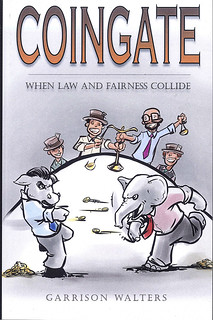 Lucas County Prosecutor Julia Bates, whose office tried the case, said the idea that theft charges should have been left off the table was “ridiculous.” “The profits could have tripled or
quadrupled, but he still took money,” she said. “He still used it for his own benefit.”
Lucas County Prosecutor Julia Bates, whose office tried the case, said the idea that theft charges should have been left off the table was “ridiculous.” “The profits could have tripled or
quadrupled, but he still took money,” she said. “He still used it for his own benefit.”
On the author’s argument of political collusion:
“I was the only Democrat in the whole circle of this case,” Ms. Bates said. “The U.S. attorney was a Republican. The [state] attorney general was a Republican. The state auditor, Betty Montgomery, was a Republican. Tom Charles, the inspector general, was a Republican. [Franklin County Prosecutor] Ron O’Brien was a Republican.
To read the complete Blade article, see:
Author argues Tom Noe ‘political prisoner’ in Coingate
(http://www.toledoblade.com/Books/2017/12/24/Author-argues-Tom-Noe-Political-prisoner-in-Coingate.html)
To read the earlier E-Sylum article, see:
NEW BOOK: COINGATE (http://www.coinbooks.org/v20/esylum_v20n53a02.html)
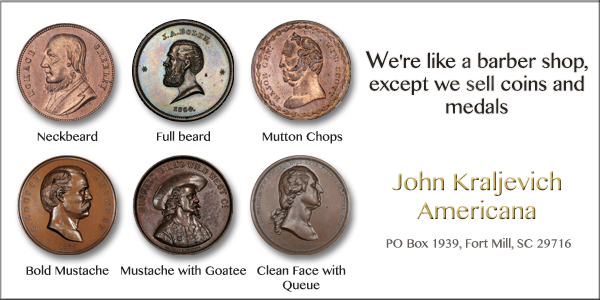
ANA PREPARATIONS FOR 2018 NATIONAL COIN WEEK

National Coin Week Celebration
2018 Theme Celebrates Unity Across Borders
To recognize the role of numismatics in building bridges and promoting unity and reconciliation, the American Numismatic Association (ANA) selected “Connecting Cultures: From Many, One” as the theme for the 95th annual National Coin Week, April 15-21. The theme was provided by ANA member Linda Mosvick.
The Association will host a variety of National Coin Week activities online and at the Edward C. Rochette Money Museum in Colorado Springs, Colo. Events and educational content focuses on U.S. and world coins throughout history, commemorative medals, monetary unions, designs on euro notes, and more.
ANA-sponsored activities for National Coin Week include:
- A writing contest open to ANA members about how numismatics creates unity. Topics can be historical and research based, or personal experiences about people coming together through numismatics. Winning and high-quality entries will be featured on the ANA National Coin Week blog and webpage. Selected entries qualify for prizes.
- An online trivia challenge. Every day from April 15-21, a new question will be released on the ANA’s social media channels and www.NationalCoinWeek.org. Participants submit their answers online for a chance to win proof sets and one-year memberships to the ANA.
- The annual coin club trivia challenge, where ANA member clubs test their numismatic knowledge and compete for prizes. A youth activity, “Bridges on Coins.” Children are provided close-up illustrations of bridges featured on coins and paper money, and challenged to identify the objects.
- Online resources on www.NationalCoinWeek.org, including articles from The Numismatist, promotional documents, links and suggestions from the ANA library and more.
- An open house at the Money Museum in Colorado Springs on Saturday, April 21, which will include free admission, activities for children and adults, and the minting of the 2018 National Coin Week medallette in the museum’s Mini-Mint.
“Symbolism is often an important part of designs on coins and currency,” said Andy Dickes, ANA collections manager and coordinator of the 2018 National Coin Week. “For example, the first coins struck for circulation at the United States Mint in 1793 were large copper cents about the size of today’s quarter-dollars, and the “tails” side design on those cents depicted a chain with 13 links forming a circle. It symbolized the unity of the 13 original colonies.”
For additional information, e-mail ncw@money.org, call 719-482-9814, or visit www.NationalCoinWeek.org.
The American Numismatic Association is a congressionally chartered, nonprofit educational organization dedicated to encouraging the study and collection of coins and related items. The ANA helps its 25,000 members and the public discover and explore the world of money through its vast array of instructional and outreach programs, as well as its museum, library, publications and conventions. For more information, call 719-632-2646 or visit www.money.org.
For more information, see:
www.NationalCoinWeek.org
VOCABULARY TERMS: COINING DIES AND COLLAR DIES
This week we have two terms which have the same meaning.Two for the price of one. Mints which produce only coins will use the term Coining Dies. Mints or medal makers which use both technologies – coining and splash striking -- will use the term Collar Dies to differentiate from Open Face Dies.

Coining Dies. Specially prepared working dies intended for use in a coining press which produces a struck piece – coin or medal – with a single blow, including some
form of edge treatment. Coining dies are made from very low relief (BAS-RELIEF) models and are always used in a coining press with a COLLAR which will produce a smooth or reeded edge. Since coining
dies must fit within a collar, they are also called COLLAR DIES. In very rare instances medals struck with coining dies without a collar, forming indistinct borders, is called SPLASH STRIKING
(q.v.).
CLASS 04.4
Collar Dies. Coining dies that specially prepared for use with a collar and to be used in a coining press. Collar dies are turned on a lathe to have a neck slightly
smaller than the diameter of the struck piece. This allows the dies to enter the aperture or center hole of the collar, forming the COINING CHAMBER, strike the piece and then retract. Actually the
dies force the blank against the restraining walls of the collar (which forms the edge, smooth or reeded); and one die ejects the struck piece from the collar. Collar dies and coining dies have much
the same meaning; they are in contrast to OPEN FACE DIES (BOX DIES in Britain), which are used with no collar at all. See DIES AND DIEMAKING.
CLASS 04.4
Looking for the meaning of a numismatic word, or the description of a term? Try the Newman Numismatic Portal's Numismatic Dictionary at: https://nnp.wustl.edu/library/dictionary
MAJOR JAMES OTIS WOODWARD (1862-1928)
 ANS Life Member Major James Otis Woodward was not exactly the sort any gentleman would want for a son-in-law.
ANS Life Member Major James Otis Woodward was not exactly the sort any gentleman would want for a son-in-law.
Major James Otis Woodward (1862-1928), was born son of Royal Woodward (1815-1882), and Charlotte Minerva Smith Woodward (1832-1924).
He had residences at 48 Grand Street, Albany, New York, and also at 558 Fifth Avenue, New York City, and also at 20 Broad Street, New York City.
He graduated Hamilton College in 1882. A member of Chi Psi Fraternity, a member of Alpha Phi.
After graduation he began to study law and became a member of the New York Bar Association.
In the September 1883 issue of Numisma he is listed as a subscriber.
From 1883-1884, he worked as the City Editor of the Troy Times.
In 1886, he was elected Alderman of Albany, New York.


To read the complete article, see:
WOODWARD, MAJOR JAMES OTIS
(https://sites.google.com/a/numismaticmall.com/www/numismaticmall-com/woodward-james-otis?pli=1)
The entire inventory of the Lupia Numismatic Library is for sale. Individual items will be available before the remaining archives are broken up into parcels sold at philatelic auctions in the U. S. and Hong Kong. Check NumismaticMall.com frequently as dozens of new items with estimates will be posted daily until everything is sold.
All inquiries will be given prompt and courteous attention. Write to: john@numismaticmall.com .
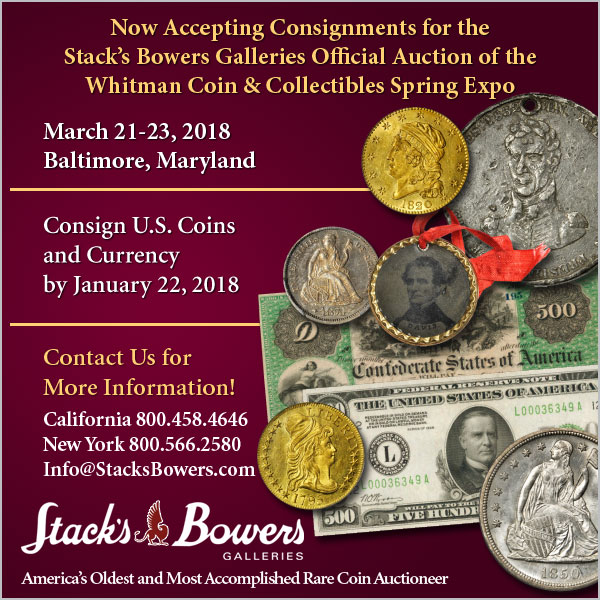
FRANK. C. ROSS AND THE ORPHAN ANNE DIME
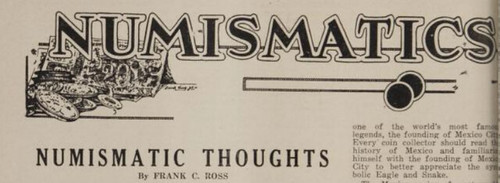
Mention of Frank C. Ross as a columnist in Hobbies magazine in last week’s E-Sylum brought back memories. He was writing for the magazine in 1946 (to 1949) when I was becoming active in numismatics. We both lived in Kansas City, but I never met him, nor did he attend any meetings of the local coin club, Heart of America Numismatic Association, while I attended regularly.
Unlike the other Hobbies columnists, who were dealers, Frank Ross was a collector, and somewhat of a “solitary writer” (I define as one who is not active in numismatic organizations). He invented the term “Little Orphan Anne” for the dime of 1844.
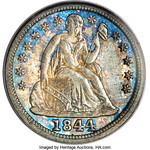 Ross had the idea the 1844 dime was scarce for some unknown reason. He formed a small hoard, and promoted it often in his Hobbies column. Breen mentioned in was hoarded but did
not mention the Orphan Anne term. I have seen it mentioned elsewhere but it has not been accepted by numismatic scholars. It lacks substance.
Ross had the idea the 1844 dime was scarce for some unknown reason. He formed a small hoard, and promoted it often in his Hobbies column. Breen mentioned in was hoarded but did
not mention the Orphan Anne term. I have seen it mentioned elsewhere but it has not been accepted by numismatic scholars. It lacks substance.
He retired in 1949 and died in 1955. I wonder whatever happened to his “hoard.”
Via a Newman Portal search I found a report on the May 7, 1948 Heart of American Numismatic Association meeting in the July 1948 issue of The Numismatist where Frank C. Ross's paper on the Little Orphan Anne dime was read. -Editor
Len Augsburger adds:
The Newman Portal revealed that Ross was actually hoarding 1846 dimes, not 1844. Ross’s 1846 dimes showed up in a Bolender sale shortly after his death, where it was reported that Ross hoarded 46s. I think he hyped 44s but secretly hoarded 46s.
This suggests to me that Ross was not the numismatic dreamer we made him out to be. He was hoarding a legitimately scarce coin and at the same time diverting his fellow collectors by publicly pumping the 1844 instead. This is numismatic duplicity well practiced – not only do you not reveal the coin you are hoarding, but you actively throw the scent in another direction.
To read the complete E-Gobrecht issue on the Newman Portal, see: https://nnp.wustl.edu/library/book/537643
To read the earlier E-Sylum article, see:
NEWMAN PORTAL ADDS HOBBIES MAGAZINE (http://www.coinbooks.org/v21/esylum_v21n01a06.html)
HARVEY STACK'S NUMISMATIC FAMILY, PART 9
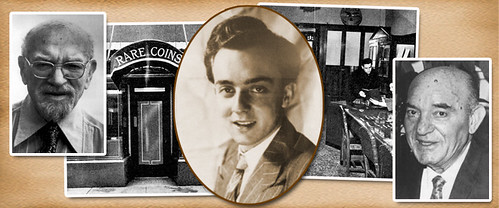
With all the activity in the coin market in the early 1950s, plus the major sales Stack's was offering at public auction, the staff and all five members of the family were kept very busy. Among the Stack family the work was divided. Morton was our chief cataloger, and he started to train Norman to continue this work, Joseph was really our "Man on the Road," for he traveled endlessly from city to city, town to town, East to West, and North to South. He met and worked with clients, bought and sold coins and took consignments from collectors nationwide. Joe trained his son Ben to also go on the road and Ben liked this part of the business. I ended up spending most of my time in the store, as a coordinator, manager, and personnel facilitator. I met and served many collectors, young and old, some who had only a few dollars and some who had virtually unlimited funds. It was always our goal to provide the best service and to help build collections, hoping always that when the collector decided to sell he would think of Stack's.
Of course, each of the young Stack's had to cover for each other and do all the different chores when needed. Each of us would travel, each would go to coin shows, each would catalog, each would work at the counter and stock coins; we all worked together to make things happen. My father Morton was in charge of getting our catalogs out, and that could be nearly every month. However, I also learned from him about printing. At that time illustrations were made photographically, then transferred to copper engravings, which were attached on blocks of wood, and inserted into catalogs so the printer could create an illustrated catalog. I learned about photographing coins, about making the copper "cuts" for illustration, how they were inserted by hand among the linotype stripes that were carrying the wording, about binding and even mailing the catalogs. In my early days, I traveled (at first with my father) down to Federalsburg, Maryland, where our printer operated. I would wait while the catalog was set into type, the pages made, the catalog printed and mailed, and I would go home to our office with bound copies. It was the training I needed to do the job when and if I had to.
Therefore, our seniors trained us to be junior professionals. We learned how to run a coin business, at a time when the field was growing in importance each year. It was an exciting time, a great learning period, and the things I was taught stick with me to this very day. In addition to the senior Stacks there were many authors and collectors who helped and taught us. For example, Dr. William Sheldon, the dean of large cents at the time, made use of our inventory, our offices and collections he could study in order to make a Condition Census, comprising the highest grade example of each date and variety. He worked with my father Morton to write his first book, Early American Cents: 1793 -1814. It was first published in 1949 and quickly became the prime reference on early American cents. Cornelius Vermeule, along with a collector who served with him in Japan, issued a specialize book on "Japanese Coinage" which Stack's published. The opportunities to learn during this era of coin collecting were incredible.
To read the complete article, see:
Growing up in a Numismatic Family Part 9 (http://www.stacksbowers.com/News/Pages/Blogs.aspx?ArticleID=2810)
To read the earlier E-Sylum article, see:
HARVEY STACK'S NUMISMATIC FAMILY, PART 8 (http://www.coinbooks.org/v20/esylum_v20n54a17.html)
PETER CLAYTON AWARDED JEFFREY NORTH MEDAL
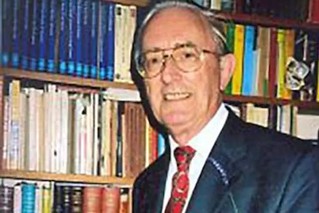 A well-known Boxmoor author, archaeologist and numismatist has been honoured with a prestigious award.
A well-known Boxmoor author, archaeologist and numismatist has been honoured with a prestigious award.
Peter Clayton is chairman of the Berkhamsted & District Archaeological Society, vice-chairman of Dacorum Heritage Trust and vice-president of the Hemel Hempstead Local History and Museum Society.
He has been awarded the Jeffrey North Medal for services to British Numismatics by the British Numismatic Society, for outstanding services to British numismatics.
Numismatics is the study of currency, including coins.
Peter is widely known as an archaeologist with particular interests in the coinage of ancient Greece and Rome, and bought his first two Roman coins as a schoolboy.
He was president of the British Association of Numismatic Societies (BANS) from 1987 to 1995 and still serves on its committee. He is a Fellow of the Royal Numismatic Society, a Fellow of the Society of Antiquaries of London and an Honorary Member of the Institute of Archaeology, UCL.
For more than 40 years, he has been a guest lecturer on cruise ships in the Mediterranean, and is the author of over a dozen books on archaeology and Ancient Egypt.
He was archaeological editor at Thames & Hudson, then became the founding managing editor at the British Museum. For 10 years, he served on the Treasure Valuation Committee at the British Museum and is now an expert advisor (coins and antiquities) to the Department for Culture, Media and Sport.
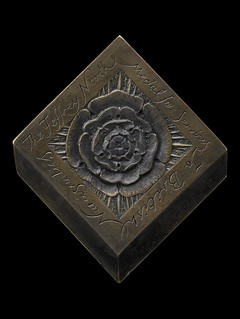
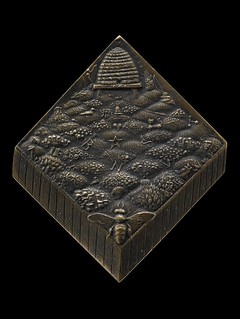
To read the complete catalog entry, see:
BNS Jeffrey North Medal
(http://www.britishmuseum.org/research/
collection_online/collection_object_details.aspx?
assetId=564704001&objectId=3172528&partId=1)
To read the complete article, see:
Prestigious award for coin expert
(https://www.hemeltoday.co.uk/news/prestigious-award-for-coin-expert-1-8315684)
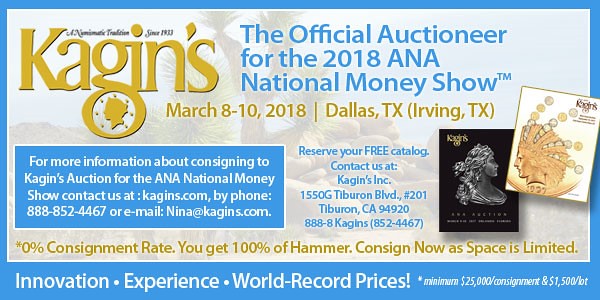
NUMISMATIC AMBASSADOR WINNERS
 Last week I received (in absentia) a wonderful honor—a Numismatic Ambassador Award.
Last week I received (in absentia) a wonderful honor—a Numismatic Ambassador Award.
I remember first reading about these awards when I was a young collector back in the 1980s. About 400 ambassadors total have been named since 1974 when Krause Publications and Numismatic News bestowed the first such recognition. Florida United Numismatists took over the administration of the awards with the 2015 nomination and election cycle.
Anyone can nominate a numismatist to receive the ambassadorship, and in recent years I’ve been pleased to fill out forms recommending friends and colleagues. I had no idea someone nominated me for 2017. “Thank you” to whoever that was! And thanks also to the body of current ambassadors, who voted to approve my membership in their ranks.
This recognition is especially significant to me because I know each of my five 2017 co-awardees personally. I’m proud to have worked closely with most of them on many numismatic projects over the years.
I remember meeting the father-and-daughter team of Steve and Ray Feller in Memphis at the Authors Forum of the International Paper Money Show in 2009. Fred Reed and I were there giving a presentation on Reed’s new book, Abraham Lincoln: The Image of His Greatness. The Fellers were discussing the subject of their recent book on the civilian camp money of World War II, Silent Witnesses. Even back then they were well known and very active in the hobby community, and it was an honor to meet them. Of course, since then Steve and Ray have continued to add to their list of contributions to numismatics, writing, speaking, and organizing for many clubs
It's a great plaque - can anyone tell us the history behind it? The awards were created by Numismatic News and later taken over by Florida United Numismatists. Who is the artist? -Editor
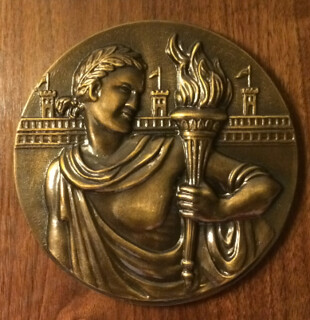
To read the complete article, see:
Numismatic ambassadorship: Inspiration to keep serving the hobby
(news.coinupdate.com/numismatic-ambassadorship-inspiration-to-keep-serving-the-hobby/)
TYRANT COLLECTION AT FEBRUARY 2018 LONG BEACH
The first public display of a portion of the extensive numismatic treasures in the recently revealed Tyrant Collection (www.TheTyrantCollection.com) will be at the February 22 – 24, 2018 Long Beach Coin, Currency, Stamp & Sports Collectible Expo (www.LongBeachExpo) and will feature a $15 million exhibit of historic English coins.
Labeled “The Tyrants of the Thames,” the inaugural exhibition in a planned multi- year series of displays from the collection will showcase more than 500 superbly preserved examples of portrait coins minted in the Thames Valley over the last 1,400 years. Among the many highlights will be a complete King Edward VIII pattern proof set produced in 1937 by the Royal Mint. It is the only privately owned set.
The collection’s owner wants to remain anonymous while he plans to share the coins through a series of exhibitions for their educational value.
"Because the collection includes the Edward VIII proof set, it is the only privately held collection that contains an example of every portrait coin denomination issued by English monarchs since the early 7th century. The upcoming exhibition will showcase many of the superb quality rarities in this amazing collection," stated the owner.
Special exhibit cases with LED lighting for easy viewing have been constructed for the exhibits planned for each of the upcoming Long Beach Expo shows over the next several years. Limited edition, illustrated hardbound, educational reference books are also in the planning stages, and these will be offered at future exhibits.
Highlights of the Treasures of the Tyrants of the Thames exhibit at the February 2018 Long Beach Expo will include:
• The finest privately held example of the gold Thrysma issued by Eadbald, King of Kent (616 – 640 AD), London Mint, S-758, graded PCGS MS64. This was the first English coin to carry the name of the issuing king.
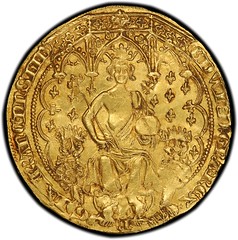

Photo: Phil Arnold/Professional Coin Grading Service
• Edward III, Plantagenet King (1327 – 1377), gold Double Leopard, S-1476, third coinage (1344 – 1351), graded PCGS MS-62. There are only three known examples of this historic coin, and the other two are in museums. It is described as perhaps the most important English coin in The Tyrant Collection.
• Henry VIII, Tudor King (1509 – 1547), gold Fine Sovereign, second coinage (1526 – 1544), S-2267, graded PCGS MS63. The largest coin issued during Henry VIII’s turbulent reign. This example is believed to be the finest known.
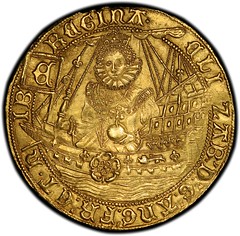
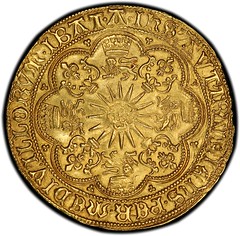
Photo: Phil Arnold/Professional Coin Grading Service
• Elizabeth I, Tudor Queen (1558 – 1603), gold “ship” Ryal, sixth issue (1583 – 1600), S-2530, graded PCGS MS61. This specimen is one of the finest known and features a fabulous design emblematic of the English navy’s historical importance.
• Charles II, Stuart King (1660 – 1685), proof or presentation gold 5 Guineas dated 1670, S-3328, graded NGC PR64 and one of the great treasures of The Tyrant Collection.
• George III, Hanover King (1760 – 1820), pattern proof gold 5 Guineas by Tanner dated 1770, S-3723, graded PCGS PR63. This is one of the rarest coins of this denomination in the English series, and another of the great treasures of the collection.
• George IV, Hanover King (1820 – 1830), gold proof Pound dated 1826, S-3797, graded PCGS PR65+ Cameo. Unlike most other 1826 issues, this magnificent cameo specimen is not marred by marks or hairlines.
• Victoria, Hanover Queen (1837 – 1901), graded PCGS PR64 Deep Cameo, this is one of the finest known examples of the world-famous Una & the Lion gold 5 Pound piece, which was obtained by the Tyrant Collection as part of a pristine original complete set of Proof 1839 coins issued for Victoria’s coronation. It is considered to be one of the world’s most beautiful coins.
The February 2018 Long Beach Expo exhibit will be the first time that the public will be able to view in the United States the historic Edward VIII proof set, the single most valuable item in English numismatics. It will also be the first time the rare King Eadbald and King Edward III coins mentioned above will be publicly exhibited in the U.S.A.
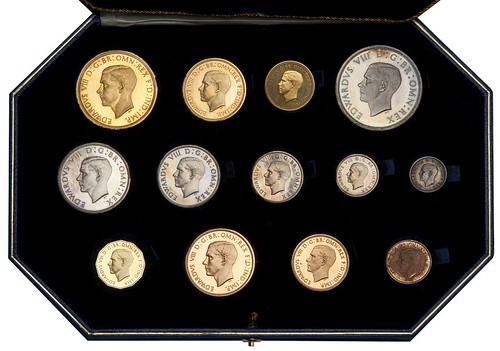
Photo: Lyle Engleson/Goldberg Coin & Collectibles
On December 11, 1936, Edward VIII abdicated his throne to marry “the woman I love.” Edward VIII then became known as the Duke of Windsor, and during his lifetime he was never able to acquire even a single English coin bearing his image.
Three of the four known complete Edward VIII proof sets are owned by Queen Elizabeth and the Royal Mint, with one of the Mint’s two sets on long-term loan to the British Museum. A fifth set, lacking gold coins, was broken up over the years and the coins were sold off separately.
“The Tyrant Collection contains the most valuable collection of English coins in private hands, and the entire coin collection undoubtedly is the world’s most valuable in private hands, worth hundreds of millions of dollars,” said Ira Goldberg, President of Goldberg Coins and Collectibles, Inc. (www.GoldbergCoins.com) in Los Angeles, California.
“These exhibits with different coins displayed at upcoming Long Beach Expos will be a once-in- a-lifetime opportunity for many collectors, dealers and the public to see in person some of the world’s most significant rare coins,” added Goldberg, who provided guidance in assembling The Tyrant Collection.
The February 2018 Long Beach Expo will be held in the Long Beach, California Convention Center located at 100 S. Pine Ave. Additional information is available at www.LongBeachExpo.com.
NUMISMATIC NUGGETS: JANUARY 14, 2018
Antoninianus of Usurper Julian of Pannonia
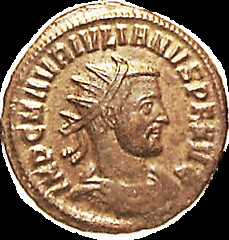

One that comes to mind is this coin of JULIAN of PANNONIA. His name does not appear on most lists of Roman Emperors because he was a usurper, a would-be ruler, who made a bid for power following the death of Numerian, in 284-85 AD. Issuing coins was one way in which such usurpers sought to legitimize themselves. This is an antoninianus, with Julian’s portrait on the obverse, and on the reverse a figure of Victory — an invocation to that goddess reflecting Julian’s hope for triumph. But he failed, was defeated, and killed. His ephemeral coins are quite rare.
(This one, graded VF, is offered in my auction of ancient and early coins closing February 6, with a starting bid of $1700. The 528-lot auction can be found at my website.
To vksit Frank's web site, see:
http://www.fsrcoin.com/
Drachm of APOLLONIA PONTIKA
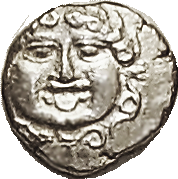
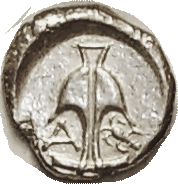
8 APOLLONIA PONTIKA, Drachm, 450-400 BC; Anchor, A & crayfish/Facg Gorgon head, S1655; AEF, sl off-ctr but full strong face; good bright silver.
1810 Batavia Copper Bonk 2 Stuivers
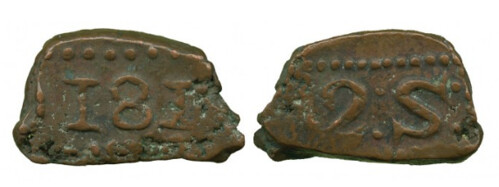
Batavia, under French rule, copper bonk 2 stuivers, 1810, 6.31g (Sch 569).
To read the complete lot description, see:
Batavia, under French rule, copper bonk 2 stuivers, 1810, 6.31g (Sch 569).
(https://www.baldwin.co.uk/batavia-under-french-rule-copper-bonk-2-stuivers-1810-z65129.html)
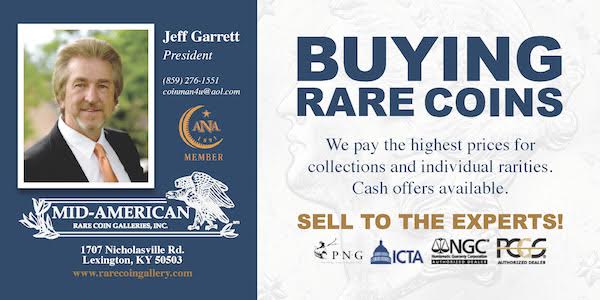
KüNKER AUCTION 303: SAXONIA IN NUMMIS
7 and 8 February 2018
Künker, Osnabrück
Auction 303: Saxonia in Nummis
Saxony takes centre stage at the Künker eLive Auction
Saxonia in Nummis is the title of auction 303 of the Osnabrück auction house Künker. It will be held as an eLive Premium Auction on 7 and 8 February 2018. If you collect Saxon coins and medals, you should not miss this auction.
762 lots with Saxon coins and medals will be presented at the eLive Premium Auction 303 of the Osnabrück auction house Künker at www.eLive-Auction.de, with 7 February being entirely dedicated to coins and 8 February being dedicated to medals. On both days, bidding will start at 6pm Central European Time.
There will be Saxon talers of all variations - from klappmützentaler to the reichstaler, from the taler-klippe to the kipper-coin, from wechseltaler to convention taler, from banco-taler to vereinstaler - if you are interested in Saxon talers, you simply cannot miss the Künker auction 303. It will contain talers starting at Frederick III the Wise and ending with King John of Saxony.
Certainly there are great rarities, as well as attractive objects in outstanding quality. But mostly, collectors will find the exact Saxon coins they still need for their collection. How about a taler of John, Elector of Saxony (1525-1532) from Zwickau? Or maybe you would prefer the thick double reichstaler of John George I, Elector or Saxony with Augustus from 1615, Dresden? How about the 1617 reichstaler on occasion of the centenary of the Reformation? Another attractive coin would be the reichstalerklippe from 1669, which was minted on behalf of John George II on occasion of the shooting at the baptism of his grandson John George IV. The coin, which was set as prize of the competition, shows the future prince as a small Heracles strangling a snake.
All those interested in the 19th century will find a great variety of coins as well. Let us just mention the extremely fine yield convention taler of Anton from the year 1828. The first part of the auction will end with the last minted talers of Germany, a double convention taler from 1872 on occasion of the golden wedding of John of Saxony.
The next day will be dedicated to medals, starting with those that show the portrait of a Saxon ruler on one side. There are 272 lots in this part of the auction. The series starts with Suite medals for Frederick II (1428-1464). The first contemporary medals are of Frederick III the Wise.
The 18th and the 19th century are particularly well-documented. A part of the medals on offer revolve around the Reformation. The newest medals of Saxon rulers in this auction are from the First World War.
Medals from Saxon cities and medals for Saxon celebrities complete the selection.
We have published a printed catalogue of this eLive Premium Auction. You can order it at Künker, Nobbenburgerstr. 4a, 49 076 Osnabrück; Tel: +49 / 541 / 96 20 20; Fax: +49 / 541 / 96 20 222; or via email: service@kuenker.de. You can also look at the auction online at https://elive-auction.de.
The viewing will take place in Osnabrück from 2 January to 27 January 2018, by appointment only.
The coins can be viewed at the Estrel Hotel in Berlin on the following days: 30 January 3pm- 6pm, 31 January 10am-6pm and 1 February 10am-6pm.
In addition, they will be exhibited at the World Money Fair on the following days: 2 February: 10am-6pm, 3 February 10am-6pm, 4 February 10am-4pm.
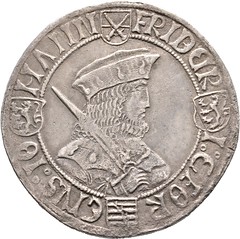
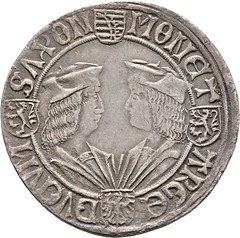
2001 Frederick III the Wise, George and John, 1500-1507. Taler n. d., Annaberg. Klappmützentaler. Very rare. Very fine. Estimate: 1,000 Euro
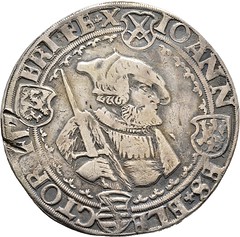
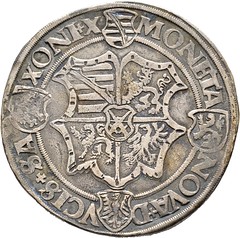
2013 John, 1525-1532. Taler n. d., Zwickau. Very rare. Very fine. Estimate: 1,000 Euro 2040 John Frederick the Magnanimous, Henry and John Ernst, 1539-1541. Taler 1539, Buchholz. Rare. Very fine. Estimate: 1,000 Euro
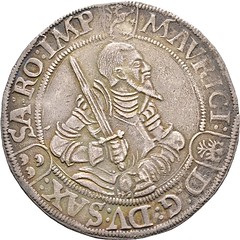
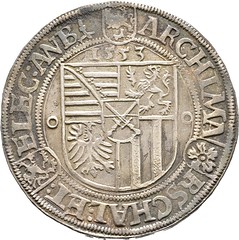
2066 Maurice, 1547-1553. Taler 1553, Annaberg. Very fine +. Estimate: 250 Euro 2169 John George I and Augustus, 1611-1615. Thick double reichstaler 1615, Dresden. Rare. Very fine. Estimate: 600 Euro
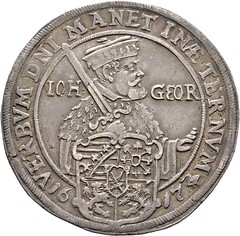
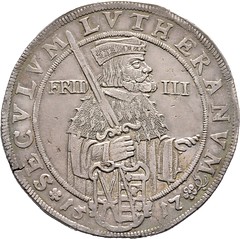
2242 John George I, 1615-1656. Reichstaler 1617, Dresden, on the 100-year anniversary of the Reformation. Very rare. Very fine to extremely fine. Estimate: 1,000 Euro
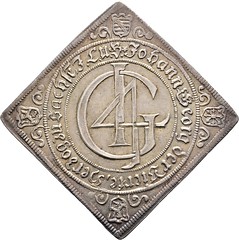
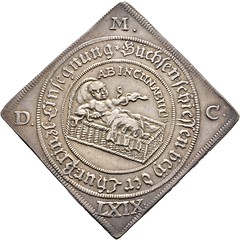
2299 John George II, 1656-1680. Reichstalerklippe 1669, Dresden, on the shooting on occasion of the baptism of his grandson John George IV. Almost extremely fine. Estimate: 750 Euro
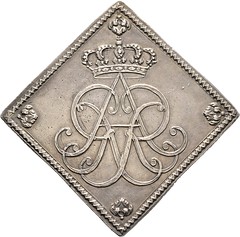
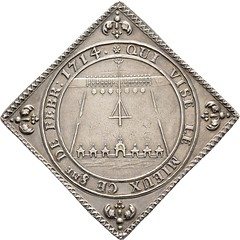
2320 Frederick Augustus I the Strong, 1694-1733. Talerklippe, Dresden, on the bird shooting to honour George William, Margrave of Brandenburg-Bayreuth. Very rare. Almost extremely fine. Estimate: 2,500 Euro
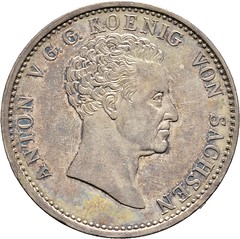

2376 Anton, 1827-1836. Convention taler 1828. Yield. Very rare. Extremely fine. Estimate: 750 Euro

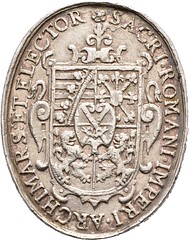
2452 John George I, 1615-1656. Oval silver medal, unsigned. Very rare. Very fine. Estimate: 500 Euro
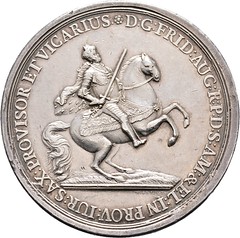
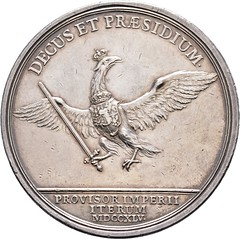
2490 Frederick Augustus II, 1733-1763. Silver medal 1745 of H. F. Wermuth on the vicariate. Very rare. Very fine to extremely fine. Estimate: 400 Euro

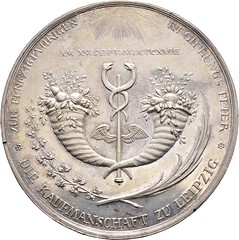
2543 Frederick Augustus I, 1806-1827. Silver medal n. d. (1819), of K. W. Höckner, on 50 years of government and the golden wedding with Maria Amalie Auguste of Pfalz-Zweibrücken. Very rare. Extremely fine. Estimate: 200 Euro
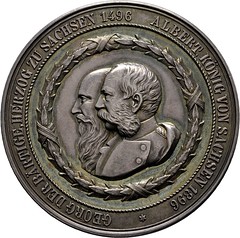
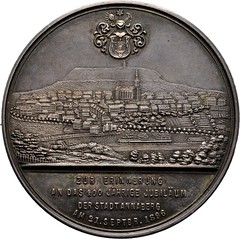
2621 Albert, 1873-1902. Silver medal 1896, unsigned, at Mayer & Wilhelm, Stuttgart, on the 400-year jubilee of the city of Annaberg. Rare. Extremely fine to proof- like. Estimate: 500 Euro
To view the complete auction online, see:
https://elive-auction.de.
WAYNE'S NUMISMATIC DIARY: JANUARY 14, 2018
Nummis Nova
Tuesday night found me settling into a chair at Mon Ami Gabi restaurant in Reston for the January 2018 meeting of my Northern Virginia numismatic social group, Nummis Nova. Fancy place - check out
the bar. Wayne Herndon was our host.
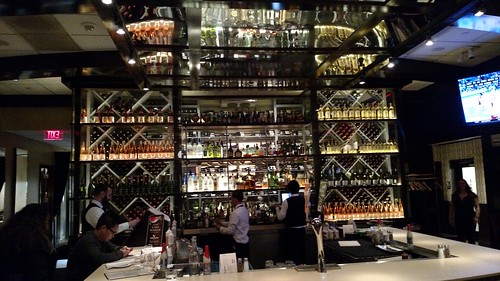
I ended up sitting at the far end of the table between Dave Schenkman and Itay Tal, a world paper money dealer from Israel who was Wayne Herndon's guest. I enjoyed our conversation about his eBay business, banknotes and my own collecting interests, including labor exchange notes.
Other attendees included Eric Schena, Steve Bishop, Roger Burdette, Julian Leidman, Mike Packard and Robert Hoppensteadt.
We didn't have a lot of exhibits this time, although Dave Schenkman passed around this nice 1872 World's Peace Jubilee medal in a large cracked slab. I'd never heard of this event, which celebrated the end of the Franco-Prussian War.

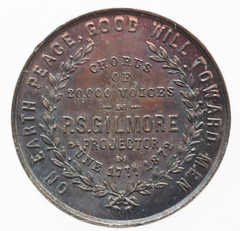
Dave adds:
It is white metal (according to the slab), 47mm.
New York International - Thursday
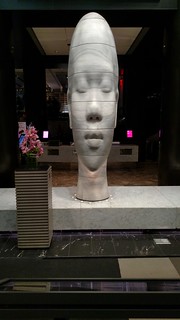 Thursday morning I pointed my car northward on I-95 on my way to the New York International coin show. Traffic was light and I even sailed through the Lincoln Tunnel. The streets of New
York were a different story. After many long blocks of crawling and maneuvering I ended up in front of the Grand Hyatt on 42nd street (see lobby sculpture at right). A valet took my car and after
checking in to my 21st floor room I took the elevator back down to the new location of the show, which had previously been staged at the Waldorf Astoria hotel a few blocks down the street.
Thursday morning I pointed my car northward on I-95 on my way to the New York International coin show. Traffic was light and I even sailed through the Lincoln Tunnel. The streets of New
York were a different story. After many long blocks of crawling and maneuvering I ended up in front of the Grand Hyatt on 42nd street (see lobby sculpture at right). A valet took my car and after
checking in to my 21st floor room I took the elevator back down to the new location of the show, which had previously been staged at the Waldorf Astoria hotel a few blocks down the street.
The first person I recognized was literature dealer Charlie Davis who had a nice setup in the registration area. Next I spoke with Chris Karstadt of Stack's Bowers Galleries, then saw Tony Terranova on his way out of the bourse. When I stepped into the bourse floor I immediately ran into John Kraljevich. He only had a minute to chat but was already having a good show. Boy, you can't swing a cat in here without hitting four top numismatists.
Here are some images of Charlie and his stock.
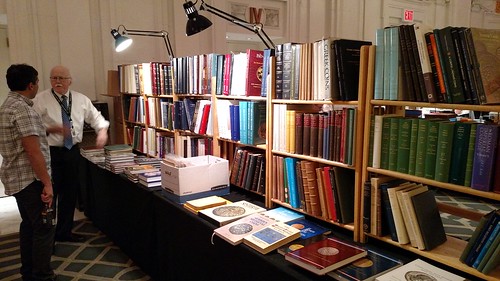
Charlie speaks with a customer
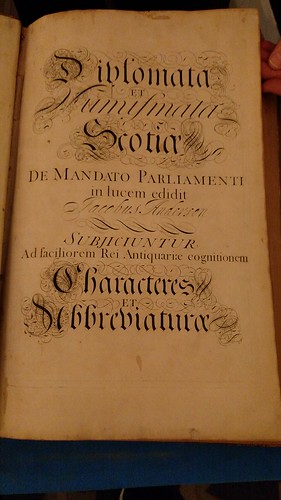
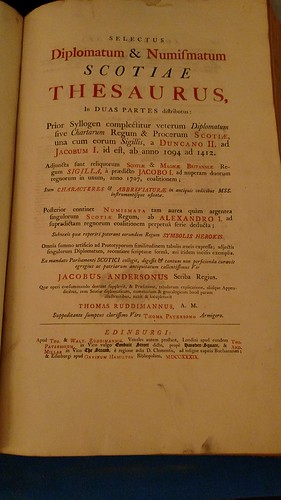
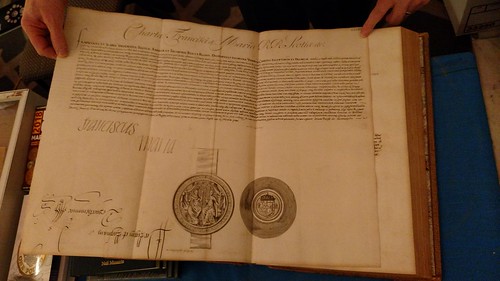
My first stop on the bourse was the Educational Coin Company table, where I purchased a few nice attributed ancient coins for our Annandale Coin Show kids' program.
Other people I encountered or chatted with included Shanna Schmidt and her mother Ellen, CoinsWeekly editor Ursula Kampmann of Germany, former American Numismatic Association officials Jeff Garrett and John Wilson, and Peter Preston-Morley of Dix Noonan Webb of London.
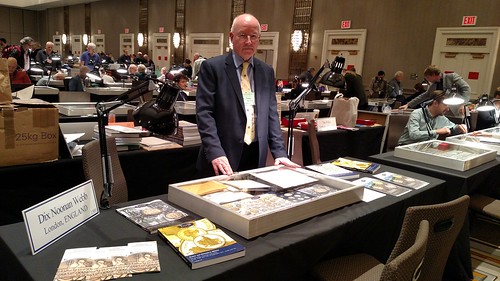
Peter Preston-Morley
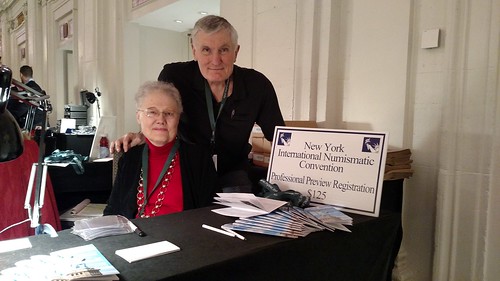
Nancy and John Wilson
Phil Mussell of Token Publishing in the UK was speaking on his phone when I arrived at his booth. While waiting I took out my wallet to place a receipt inside. Phil finished his conversation just as I was putting my wallet back in my pocket and protested: "You can't put your wallet away - you've gotten me all excited about making a sale!" We had a good laugh and I did indeed make a purchase, but had to ask him to hold my books until I'd replenished my cash supply. I picked them up on Friday.
The ANS Gala
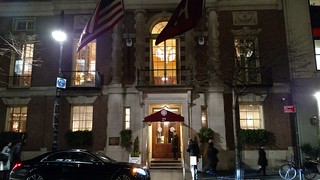 Back in my room I worked a bit on The E-Sylum, then put on my suit, tie and overcoat for a walk over to the Harvard Club of New York, where I would be attending the American
Numismatic Society Gala. Here's a shot of the outside of the building.
Back in my room I worked a bit on The E-Sylum, then put on my suit, tie and overcoat for a walk over to the Harvard Club of New York, where I would be attending the American
Numismatic Society Gala. Here's a shot of the outside of the building.
I was about 20 minutes early and so was John Lupia. We chatted a bit and John directed me to the coat check before we made our way upstairs for the reception. There I mingled, met and spoke with a very wide cross-section of today's numismatists, including Clifford Mishler, Vicken Yegparian of Stack's Bowers, Bruce Walker of A-Mark, Aaron Berk, Dan and Connie Hamelberg, George Kolbe and David Fanning, David Hendin and Mary Lannin.
After stuffing my face with countless hors d'oeuvres served by a large waitstaff, some 180 attendees next wended their way back downstairs to the main dining room.

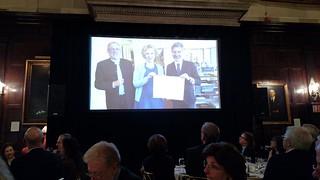 There I spoke with Jeff Garrett, John and Regina Adams, and several others. I was seated at table #11 between retired ANS Librarian Frank Campbell and David Fanning. Others at my table
included George Kolbe, Barry Tayman, Len Augsburger, and his wife Debra Kurtz.
There I spoke with Jeff Garrett, John and Regina Adams, and several others. I was seated at table #11 between retired ANS Librarian Frank Campbell and David Fanning. Others at my table
included George Kolbe, Barry Tayman, Len Augsburger, and his wife Debra Kurtz.
The Gala was in honor of the Rosen Family, and the tributes were effusive and touching. Andrew Reinhard gave an entertaining review of the year's event's at ANS, and a rousing auction raised additional funds for the organization.
After a wonderful dinner and program I mingled anew, speaking with another great group of folks including Jay Galst, Syd Martin, Ray Williams, Chris Salmon, Mark Anderson. and Mark Tomasko.
I don't think I made it back to the hotel until 11pm. It had been a long day, but it was quite a memorable day of numismatic fellowship.
The Newman Portal Breakfast Summit
Friday morning brought more rain, and I hoisted my umbrella while making my trek several blocks away to The Smith restaurant on 2nd Avenue. There I met Newman Numismatic Portal Project Coordinator
Len Augsburger and for a couple hours we discussed NNP plans and ideas for 2018 and beyond.
Back at my hotel I worked on The E-Sylum some more before heading back into the show.
New York International - Friday
Stepping out of the elevator I was motioned over by Ursula Kampmann of CoinsWeekly, and we had a nice chat at her secluded table. Along came Charles Morgan and Mike Markowitz of
CoinWeek and we had a friendly mini-summit of online numismatic publishers.
Afterwards Charles, Mike and I found a secluded corner and soon I was being live stream interviewed on Facebook! I think it worked out well, and you can view the CoinWeek video here:
https://www.facebook.com/CoinWeek/videos/10156121354944106/
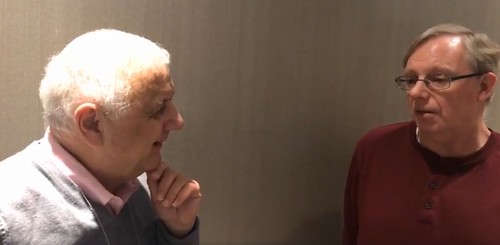
Mike Markowitz and Wayne Homren
Kolbe-Fanning Lot Viewing
Next I was off to find the lot viewing room for the Kolbe-Fanning numismatic literature sale. Just outside the room I recognized numismatic literature dealer Douglas Saville from Reading, England. We
had a nice hallway chat and later spoke again in the room, where there was a steady stream of bidders. I also spoke briefly with Dan Hamelberg and Maria Fanning. Here are some pictures I took.
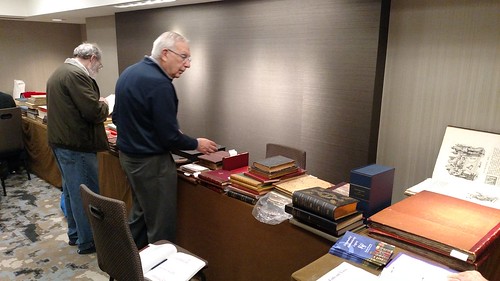
Dan Hamelberg, right

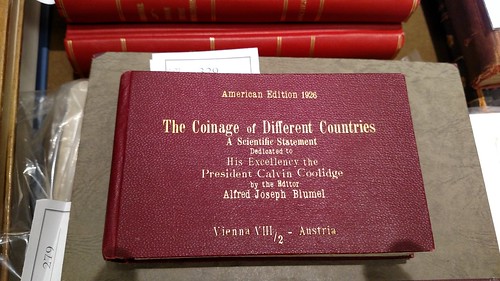
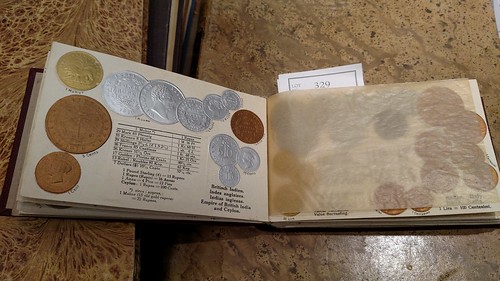
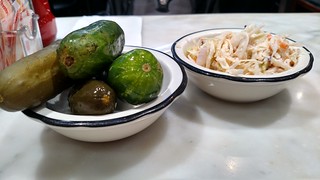 The Kolbe-Fanning crew had already ordered lunch from the nearby Bloom's deli. So I went out and had a sandwich there. Check out the pickles. Back at the show I visited the ANS table
where I spoke with Andrew Reinhard and Bob Leonard. Next I ran into Maureen and Stu Levine at Paul Bosco's table.
The Kolbe-Fanning crew had already ordered lunch from the nearby Bloom's deli. So I went out and had a sandwich there. Check out the pickles. Back at the show I visited the ANS table
where I spoke with Andrew Reinhard and Bob Leonard. Next I ran into Maureen and Stu Levine at Paul Bosco's table.
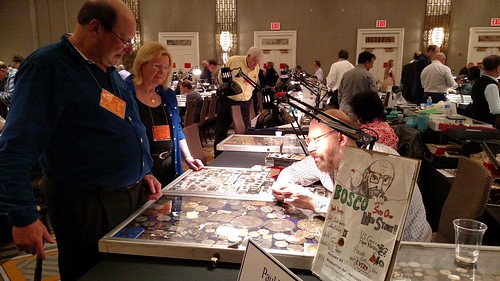
Maureen and Stu Levine at Paul Bosco's table

Paul Bosco
Others I spoke to next included Ron Gillio, David Lisot, Tony Terranova, and Kyle Ponterio.

Ron Gillio, winner of best bow tie contest

Tony Terranova
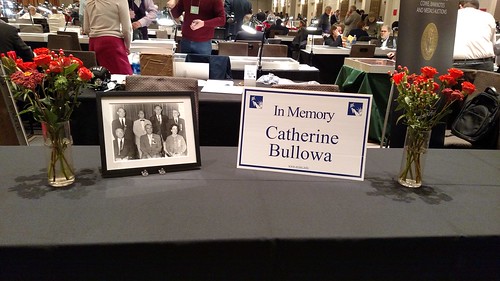
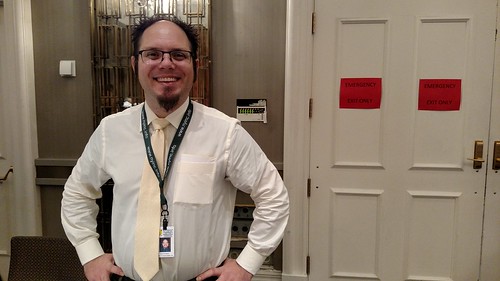
Kyle Ponterio
Dinner with CoinWeek
After heading back to my room to work a bit on email and download my pictures, I met Charles Morgan, Mike Markowitz, and Jeff Garrett at the show. Jeff was catching a flight home, but Charles, Mike
and I went out in search of a restaurant for dinner. We found Patsy's, an Italian place a few blocks away. We had a leisurely dinner with topics all over the map from numismatic publishing to
Presidential politics.
Back at the hotel I worked another couple hours and called it a night. By about 9am Saturday I was back in my car scooting out through the Lincoln Tunnel. I made it home by lunchtime and that night went to my son's Senior Class Play with my wife and daughter.
It had been another whirlwind numismatic trip, but it was quite satisfying. So many great people! Many thanks to everyone I met - the pleasure was all mine.

ONLY KNOWN GSA HARD PACK 1893-CC MORGAN DOLLAR

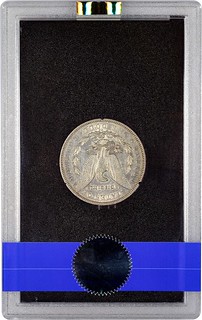
Numismatic Guaranty Corporation (NGC) has graded the only 1893-CC Morgan Dollar known in a GSA Hoard "hard pack." The unique rarity was submitted to NGC at last week's 2018 Florida United Numismatists (FUN) show in Tampa, Florida.
"GSA Hoard" is the name for a cache of several million silver dollars that had been held in the vaults of the US Treasury Department and later sold by the General Services Administration (GSA) from 1972 to 1980. The vast majority of these coins were Morgan Dollars from the Carson City Mint, identified by the "CC" mintmark below the eagle. The most common of these were the 1882-CC, 1883-CC and 1884-CC.
Uncirculated silver dollars were sold by the GSA in hard plastic cases termed "hard packs" by collectors, while circulated examples, along with Uncirculated Eisenhower Dollars, were sold in flexible plastic holders called "soft packs" by collectors.
Coins pedigreed to the GSA Hoard are extremely popular among collectors, particularly when the coins are still encapsulated in the original GSA Hoard holders. NGC grades both the hard packs and soft packs while keeping the original holders intact. For hard packs, NGC wraps a distinctive blue band with the coin's description and grade around the holder. Soft packs are encapsulated in a flexible holder along with a label bearing the coin's description and grade.
NGC has graded more than 132,000 Morgan Dollars in GSA Hoard hard packs. None have been dated 1893-CC, making the coin submitted at FUN the sole 1893-CC GSA Hoard hard pack silver dollar ever certified by NGC. (Two 1893-CC silver dollars in soft packs have been certified by NGC.)
To read the complete article, see:
NGC Certifies Only 1893-CC Morgan Dollar in a GSA Hoard “Hard Pack”
(https://www.ngccoin.com/news/article/6363/1893-cc-morgan-gsa-hard-pack/)
THE RARE KEW GARDENS 50P COIN
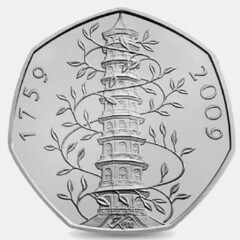 Your stash of 50p coins may say 50p, but they could actually be worth far more than face value, according to a Royal Mint employee.
Your stash of 50p coins may say 50p, but they could actually be worth far more than face value, according to a Royal Mint employee.
That’s because there are hoards of unique 50ps that are considered rare, because of how many were minted. And they could bag you hundreds of pounds.
Specfically, the coins that could win you a small fortune are a range of Kew Gardens Chinese pagoda coins. The coins were brought out in 2009 with the unique pagoda design on them, put together by President of the Royal Academy Christopher Le Brun.
Although it looks great, it’s its ‘unique’ factor is what gives it it’s high price tag. Only 210,000 of these coins were minted. Seems like a lot, right? But not when you hear that there’s usually over a billion 50p pieces in circulation.
The 50p coins are apparently so valuable to collectors that many will pay between £200 – £400 for them – over 50 times their actual value!
To read the complete article, see:
Fancy making a profit on your 50p coins? Of course you do!
(http://www.womanmagazine.co.uk/lifestyle/unique-50p-coins-earn-you-a-fortune-67205)
David adds:
It is an interesting article but I think the valuations should be taken with a pinch of salt. Interesting use of the word “unique”!
Also, I learnt yesterday that 50 p Kew coins are being faked which I was unaware of.
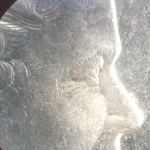

Genuine (Left) and Counterfeit (Right)
Counterfeit 2009 Kew Gardens 50p coins are known to exist. The style is similar to the fake Magna Carta £2 coin and others that can regularly be purchased direct from a Chinese auction website. I always find that the eye (of the Queen) is the most obvious giveaway, as for some reason forgers often have difficulty getting the eye detail right. The forgery on this page at 7.2 grammes is also 10% lighter than a real one which should be 8 grammes. It’s diameter is also a tiny amount less than the 27.3mm that it should be.
To read the complete article, see:
2009 Fifty Pence FAKE KEW.
(http://www.checkyourchange.co.uk/50p-coins-in-circulation/2009-fifty-pence-fake-kew/)
To read earlier E-Sylum articles, see:
ROYAL MINT ISSUES 2009 KEW GARDENS 50 PENCE COIN (http://www.coinbooks.org/esylum_v12n24a19.html)
BRITONS SEARCH FOR RARE KEW GARDENS 50P COIN (http://www.coinbooks.org/esylum_v17n08a25.html)
DAVID PICKUP: UNCOMMON THOUGHTS AND RARITIES (http://www.coinbooks.org/esylum_v17n37a32.html)
THE ARAUCANIA – PATAGONIA 100 PESOS
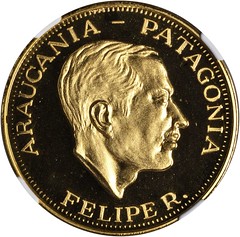
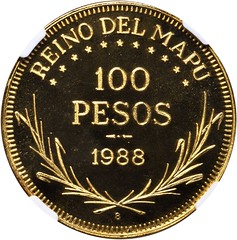
The story of this unrecognized kingdom began in 1860 when French lawyer and adventurer Orelie-Antoine de Tounens visited the region and turned sympathetic to the local tribal leaders struggling for independence against the governments of Chile and Argentina. His efforts were futile against the might of the Chilean military, which captured, imprisoned and deported him on multiple occasions and, at one point, locked him in a madhouse. Before he died penniless in Paris, he anointed a successor, a fellow Frenchman and Champagne salesman named Gustave Laciarde, who upon accession styled himself King Aquiles I. One hundred and twenty-eight years after the founding of the kingdom, then-Prince Philippe (said to have purchased the title) authorized coinage to be produced. The obverse features a right facing bare head of Philippe, with "Araucania – Patagonia" around and "Felipe R." below. The reverse displays a half wreath, with "Reino Del Mapu" above and "100 / Pesos / 1988" at center. The coin offers an interesting view into this curious and sometimes comic period of history.
To read the complete lot description, see:
ARGENTINA. Araucania-Patagonia. 100 Pesos, 1988. (https://auctions.stacksbowers.com/lots/view/3-96LUW)
ARTICLE HIGHLIGHTS ST. LOUIS ELONGATED CENTS
 Grip the handle and turn the crank. Watch the roller turn. Wait for that clink, reach into the little door. Turn over the still-warm, copper-colored oval in your palm. Smile. • It’s a
pretty penny. • Better known as a smashed penny, or, as collectors call it, an “elongated coin.” • You probably have a few in the bottom of a junk drawer or coin jar. • Your kids have probably
spotted a machine at a zoo or museum and begged you to make one. • Dig them out and look at them carefully. Did you make a memory, too?
Grip the handle and turn the crank. Watch the roller turn. Wait for that clink, reach into the little door. Turn over the still-warm, copper-colored oval in your palm. Smile. • It’s a
pretty penny. • Better known as a smashed penny, or, as collectors call it, an “elongated coin.” • You probably have a few in the bottom of a junk drawer or coin jar. • Your kids have probably
spotted a machine at a zoo or museum and begged you to make one. • Dig them out and look at them carefully. Did you make a memory, too?
“There’s lots of things you can buy that won’t last. These things are made to be permanent,” said Charlie Blair of Granite City, whose collection of 4,000 to 5,000 coins includes favorites he and his daughter Faith, 15, have collected from zoos around the country. They first started collecting when they went to the St. Louis Zoo for a field trip when she was in first grade.
“There’s a lot of artwork that goes into it — and the detail you can get on some of these. It’s a neat, inexpensive hobby.”
The methods haven’t changed much over the years: you put your coin into a machine equipped with two steel rollers. The rollers press against one another with such force to smash the coin. One of the rollers is engraved with a die that presses a design onto the coin.
The St. Louis Zoo has 14 machines on the grounds, and two make special, larger medallions. They’re state-of-the-art machines from a vendor called the Penny Men, and you can pay for your pennies with unsmashable currency: a credit card or Apple pay. Some machines will provide a penny to smash if you don’t have one in your wallet or pocket.
Ryan Jeffery, director of visitor services at the zoo, said the machines have made $222,000 in gross revenue since they started using the vendor in March 2016. “This is big money,” he said, “and it takes no effort whatsoever to do. I wish that all parts of my job were this easy.”
The zoo will sometimes make suggestions for new penny designs, such as a grizzly bear for Grizzly Ridge, a new habitat which opened in the fall. The gift shops also sell holders for the coins, like special rubber bracelets and keychains.
To read the complete article, see:
Smash a penny, pick it up: Elongated coin machines
make memories (http://www.stltoday.com/lifestyles/smash-a-penny-pick-it-up-elongated-coin-machines-make/article_40aa8598-b007-5cfd-a9b5-0fa557db2956.html)

THE CANADA 150 MEDAL
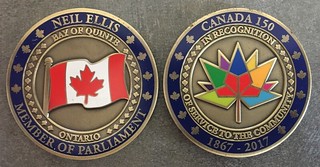 More than 60 residents of Quinte, Ont. were awarded with a Canada 150 commemorative medal during at a ceremony held in Belleville last month.
More than 60 residents of Quinte, Ont. were awarded with a Canada 150 commemorative medal during at a ceremony held in Belleville last month.
Commissioned and presented by Bay of Quinte MP Neil Ellis, the Canada 150 medals were awarded to any constituent of the riding who “demonstrated a high level of individual excellence and achievement in any field benefiting the people of the Bay of Quinte Riding.” It was awarded to recognize individual achievements as well as entire bodies of work
To read the complete article, see:
Canada 150 medals presented to Quinte residents
(https://canadiancoinnews.com/canada-150-medals-presented-quinte-residents/)
INDIAN BEGGARS REFUSING ONE RUPEE COINS
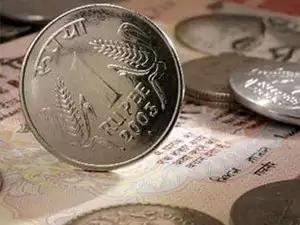 Unhappy with the small size of the one rupee coin, a group of beggars in Uttar Pradesh's Rampur has decided not to accept it anymore.
Unhappy with the small size of the one rupee coin, a group of beggars in Uttar Pradesh's Rampur has decided not to accept it anymore.
Prime Minster Narendra Modi demonetised Rs 500 and Rs 1,000 currency notes, now we demonetise the one rupee coin as it's size is similar to 50 paise coin, Shukra Mani, a beggar said.
The beggars have alleged that even the shopkeepers, rickshaw pullers do not accept these coins from them because of its smaller size.
To read the complete article, see:
Beggars 'demonetise' one rupee coin in
Uttar Pradesh (https://economictimes.indiatimes.com/news/politics-and-nation/beggars-demonetise-one-rupee-coin-in-uttar-pradesh/articleshow/62415898.cms)
To read the earlier E-Sylum article, see:
CHINA IS ALREADY LARGELY CASHLESS (http://www.coinbooks.org/v21/esylum_v21n01a36.html)
THE $50 GOLD SLUGS OF GRANVILLE P. SWIFT
 "Swift was one of the best miners I ever knew," a fellow prospector said. "It seems as if he could almost smell the gold. He made an immense amount of gold. When these three
men had worked all winter and fall, I believe they must have made $100,000 apiece and maybe more."
"Swift was one of the best miners I ever knew," a fellow prospector said. "It seems as if he could almost smell the gold. He made an immense amount of gold. When these three
men had worked all winter and fall, I believe they must have made $100,000 apiece and maybe more."
According to an 1875 story in the Sonoma Democrat, Swift left Bidwell's Bar with over half a million dollars in gold. He brought it to San Francisco and had it minted into octagonal slugs, $50 each, with a special mark designating them as Swift's.
Loaded down with gold — and without a banking system to receive it — Swift decided to start burying his haul around the Bay Area, primarily in the Sonoma area. The only problem was, he was very bad at remembering where he'd hidden it all. Although Swift died in 1875, the secret died long before then, forgotten by the scatter-brained settler.
Over time, some of the gold was found. In 1903, a worker on a ranch in Sonoma County dug up $7,000 in Swift's $50 slugs. A year later, $30,000 in gold was pulled from a chimney hiding place on Swift's old ranch near present-day Sears Point.
 "While repairing a chimney on the second floor of the place, workmen came across a secret receptacle containing $26,000 in gold coin," the Healdsburg Enterprise reported.
"In other places more money was found, the total sum aggregating more than $30,000."
"While repairing a chimney on the second floor of the place, workmen came across a secret receptacle containing $26,000 in gold coin," the Healdsburg Enterprise reported.
"In other places more money was found, the total sum aggregating more than $30,000."
The biggest discovery came in 1914. A.W. Lehrke, a Sonoma Valley rancher, woke one morning with the remnants of a dream still foggy in his mind. The bit he could remember clung to him: He was digging under his home for gold. The thought must have needled him, because he decided to put the dream to rest by doing just that. He descended into his basement and began digging. And there, amazingly, he found $42,600 in gold coins.
"The [cache] unearthed as a result of Lehrke's dream is believed to have contained one of Swift's hidden hoards," the Santa Rosa Press-Democrat wrote.
Since 1914, though, the remainder of Swift's enormous haul has gone undiscovered.
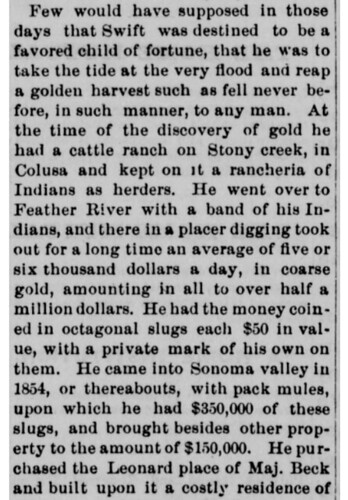 American Numismatic Biographies author Pete Smith writes:
American Numismatic Biographies author Pete Smith writes:
The story does not ring a bell. I checked my clipping file and there is nothing there about Swift. My clipping file has a lot of material that did not get into American Numismatic Biographies.
Private Gold Coins and Patterns of the United States author Don Kagin writes:
An intriguing story but this is the first I’ve heard of it. I am a bit skeptical as I’ve never heard of or seen anything that matched this description.
To read the complete article, see:
A settler forgot where he buried $100,000 in gold around the Bay Area. It might
still be out there. (http://www.lmtonline.com/bayarea/article/bay-area-settler-forgot-where-he-buried-gold-1850s-12488116.php) Sonoma Democrat, Number 28, 1 May 1875 - A Checkered Life
To read the original newspaper article: (https://cdnc.ucr.edu/cgi-bin/cdnc?a=d&d=SD18750501.2.16&srpos=6&dliv=none&e=-------en--20-SD-1--txt-txIN-)
ARTICLE HIGHLIGHTS THE SADDLE RIDGE HOARD
The article doesn't even spell "hoard" correctly throughout - really, "horde"? Twice? But it has some pretty pictures of the treasure. -Editor
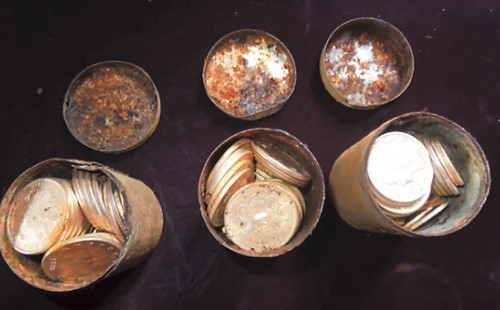
One morning in February of 2013, much like any other morning, a couple in California were walking their dog along their property. But on this particular walk, one of them noticed something strange on the side of the trail. The woman, Mary, had spotted an old tin can poking out of the ground.
Intrigued, Mary and her husband John carefully worked the tin out of the dirt. As they did, they uncovered something that would change their life forever: 1,411 gold coins. The coins were obviously old, minted somewhere between 1847 and 1894, but they were in good condition. Incredibly, as the couple found out shortly afterward, they were worth about $10 million dollars.
It was the largest discovery of lost treasure in U.S. history. Yet no one could figure out how it got there.
But why would someone bury a fortune in coins on their property and never come back to claim them? There are a few possibilities. Some have suggested that the coins came from a 1901 bank heist in San Francisco when an employee walked out with around $30,000 in gold coins. Given the timing and the value of the coins stolen, it would make sense.
Unfortunately, the U.S. Government has stepped in to rule this theory out. According to the Treasury, the coins found in the horde don’t match those you’d expect to see from that particular bank robbery.
To read the complete article, see:
The Mystery Of The Biggest Buried Treasure Find In U.S. History (http://all-that-is-interesting.com/saddle-ridge-hoard)
FEATURED WEB SITE: CHECK YOUR CHANGE
This week's Featured Web Site is Check Your Change, a guide to British error coins and paper money.Welcome to the original ‘Check Your Change’. Your comprehensive guide to Britain’s circulating coins (plus all other decimal coins right back to 1968) and Bank of England bank notes.
100s of pages of information, conveniently and logically organised and smart phone friendly!
People have been checking their change with the help of ‘Check Your Change’ for 52 years! The Original Check Your Change is now online and more interactive than ever before.
Use this website to be able to quickly see what decimal coins were made, the history and information behind the events, mintage numbers and the Rotographic collectability scale. Significant new issues (with the emphasis on standard coinage rather than precious metal issues) and other related decimal coins developments will be added here.

www.checkyourchange.co.uk

